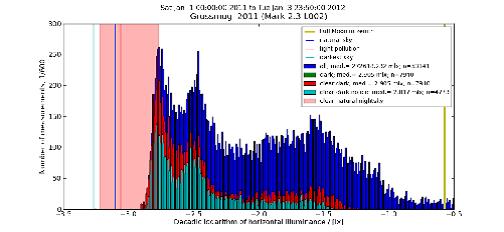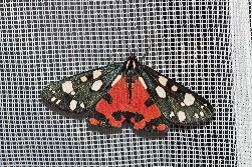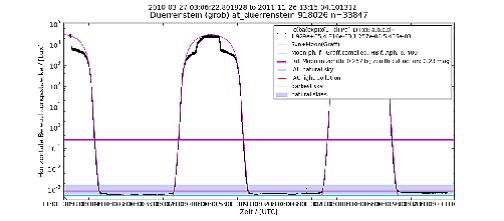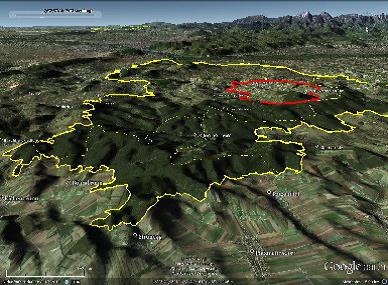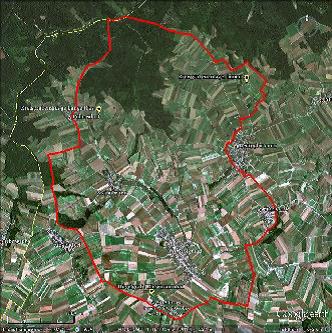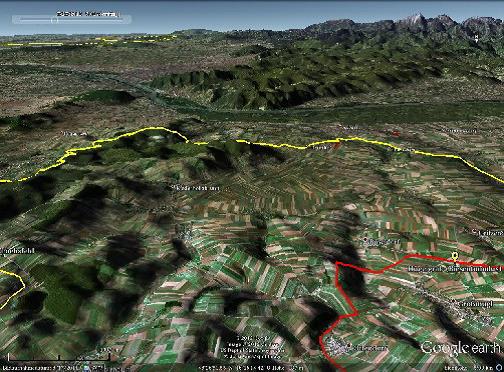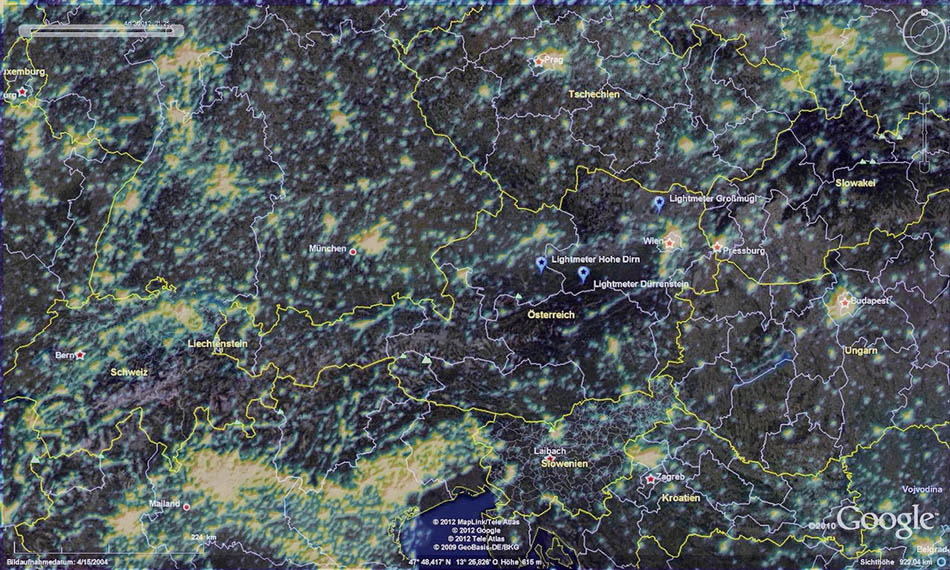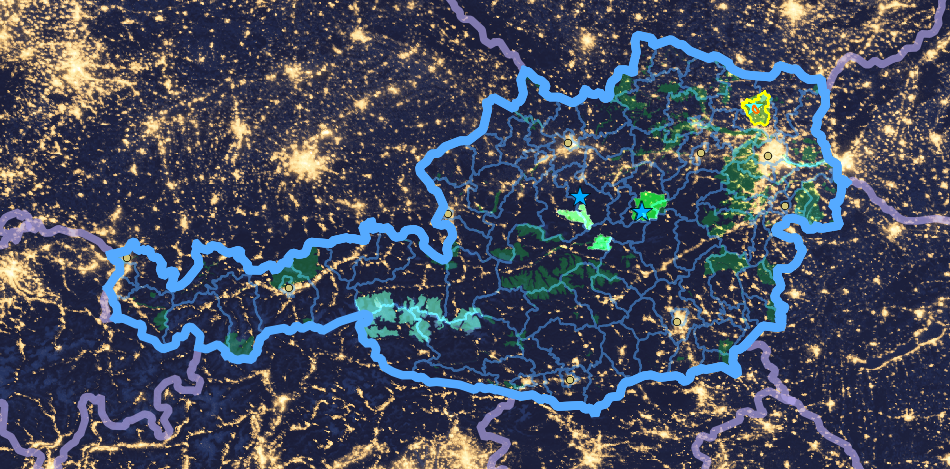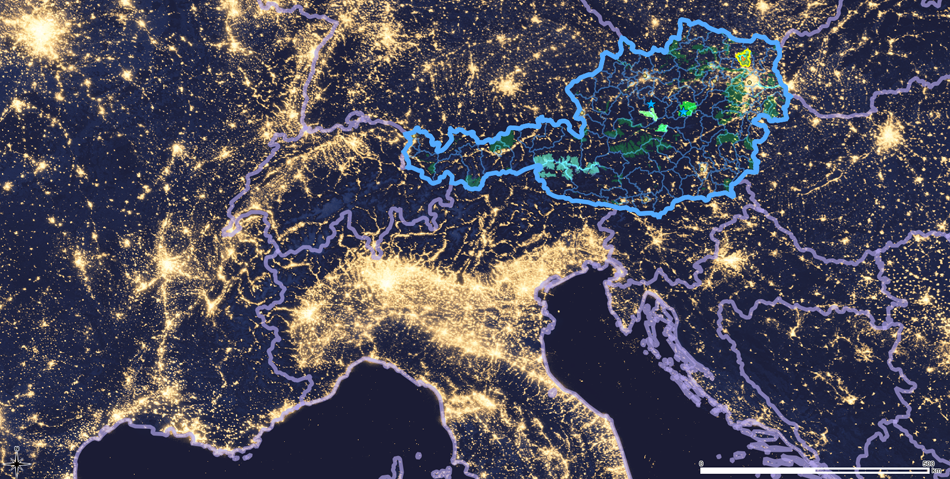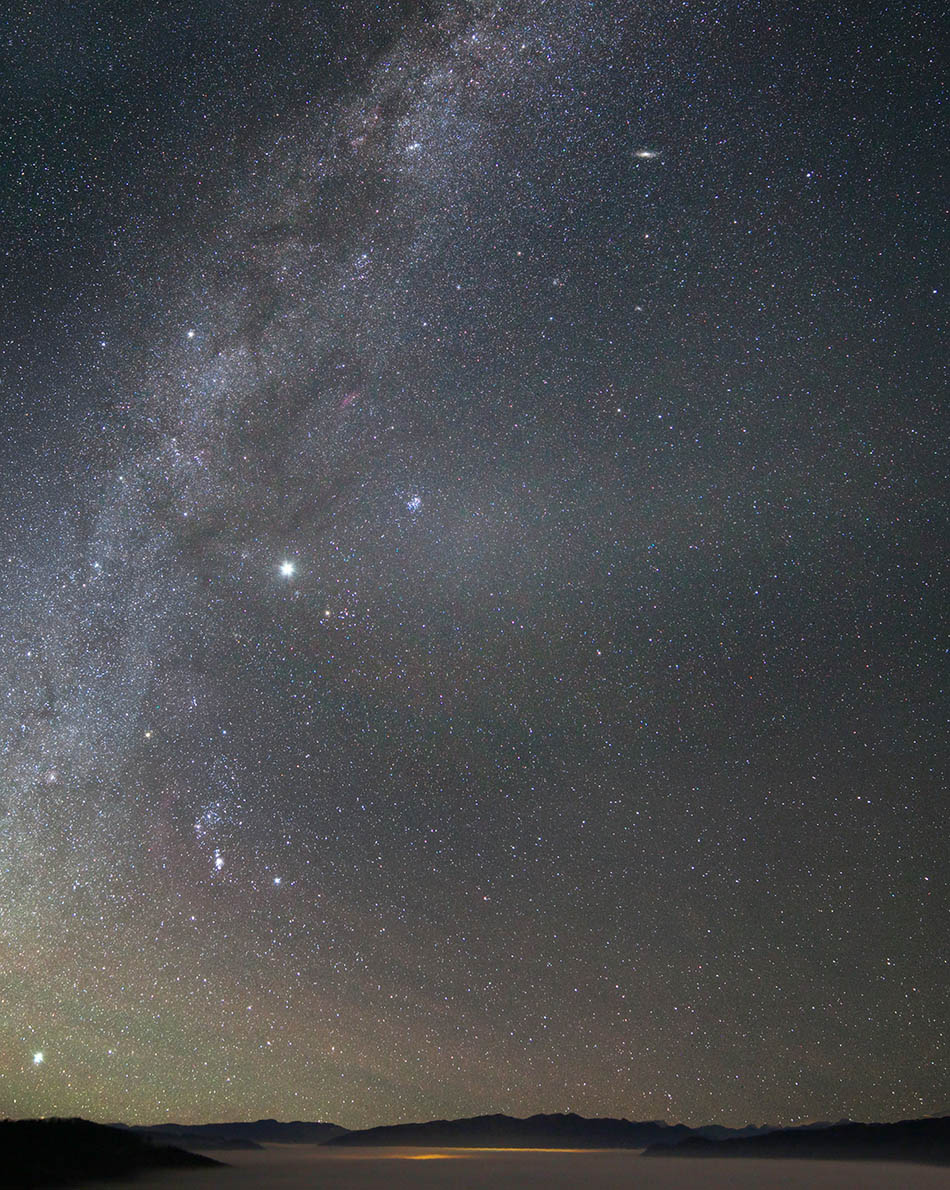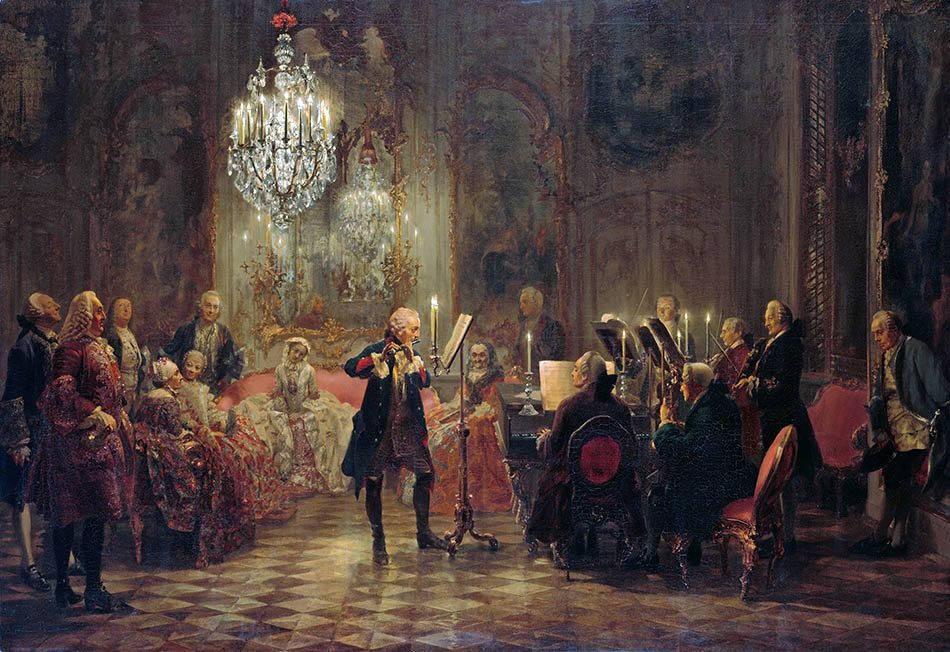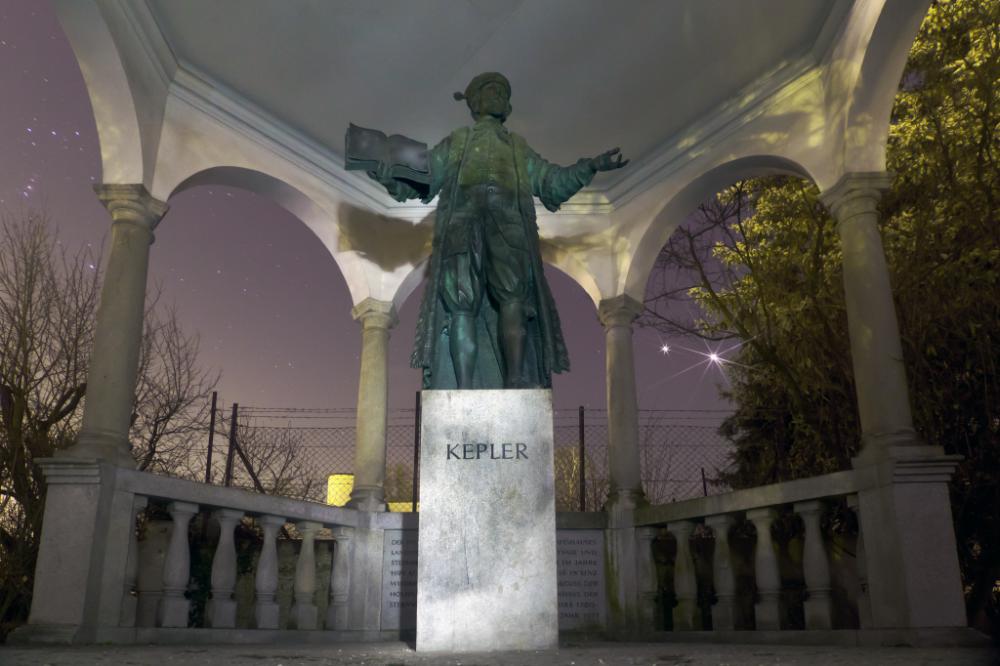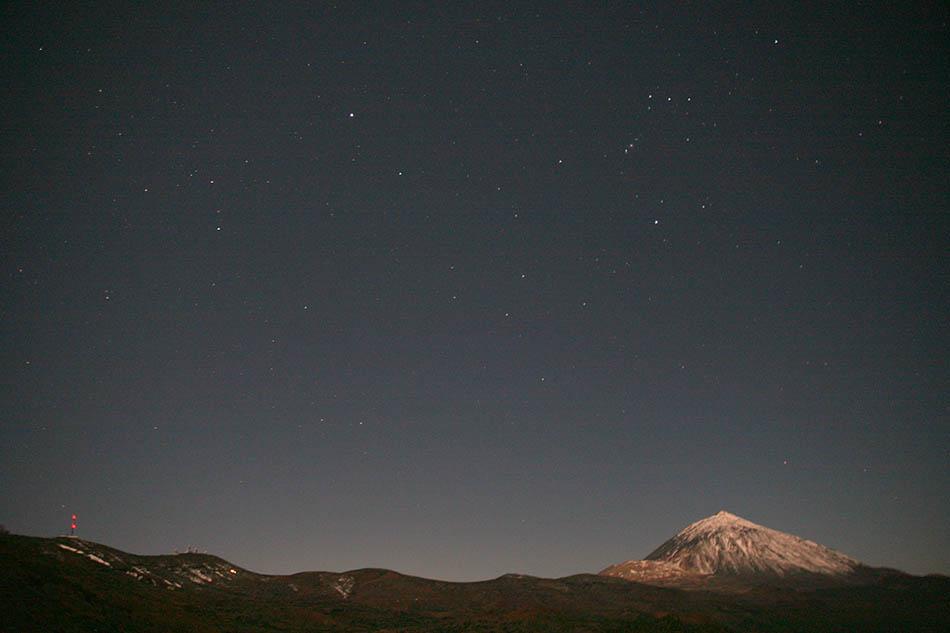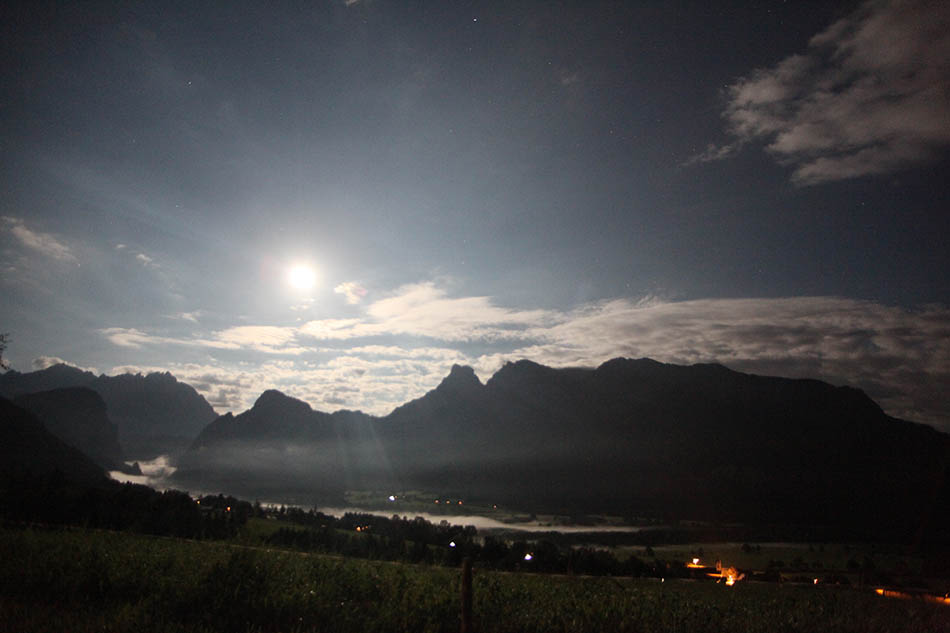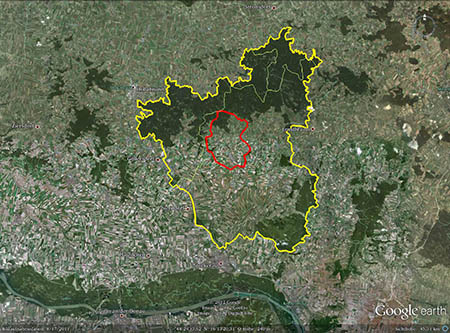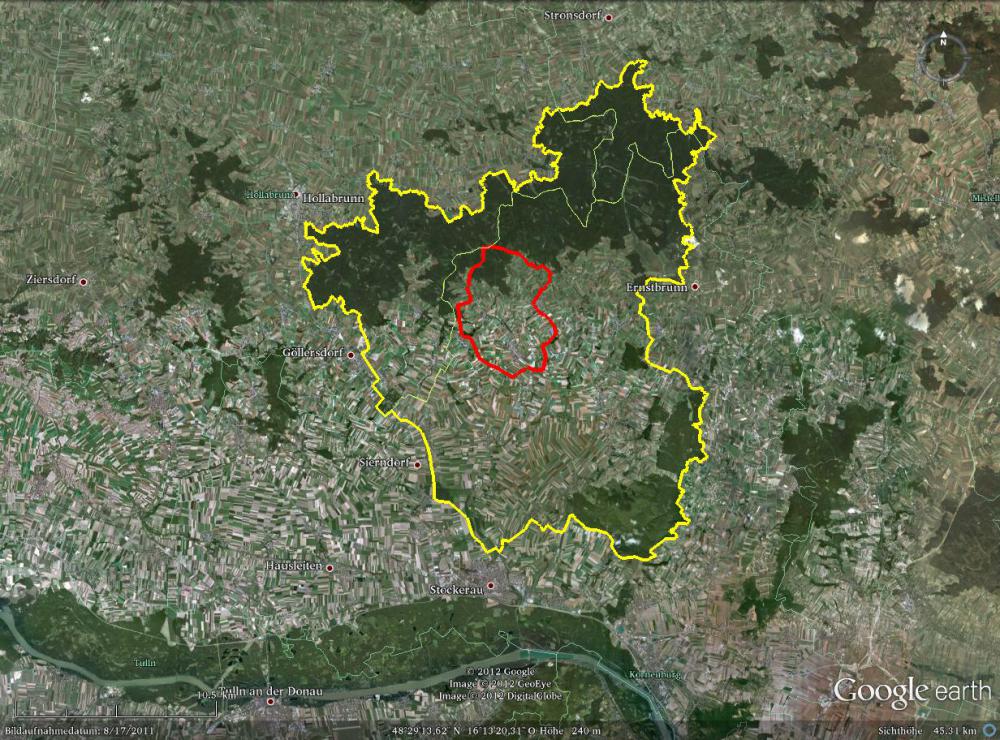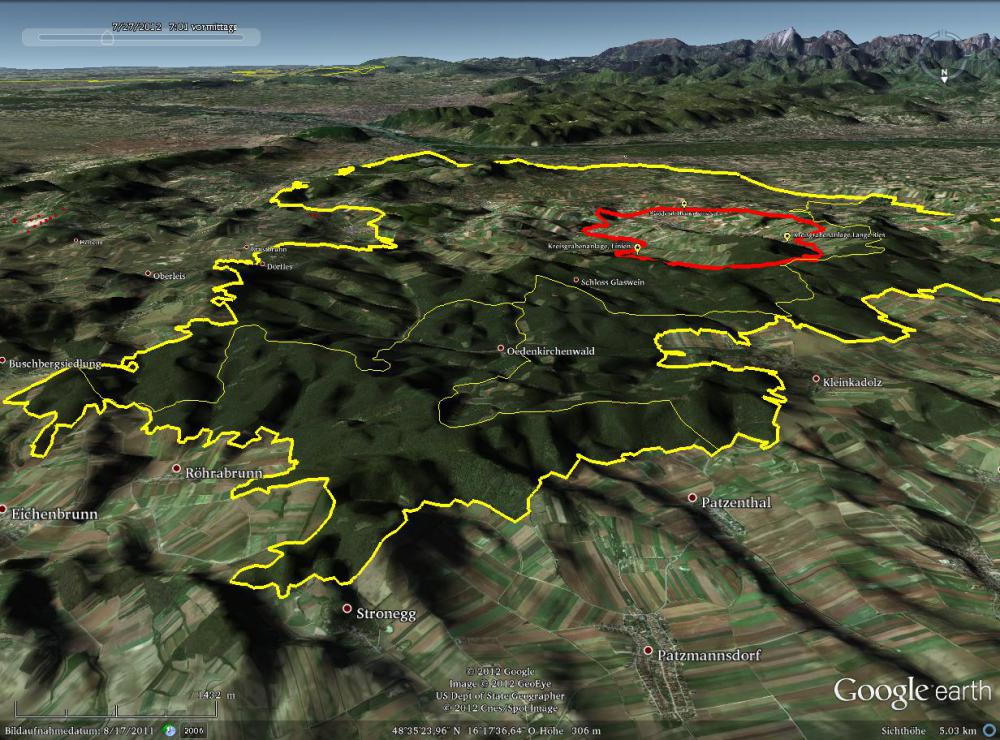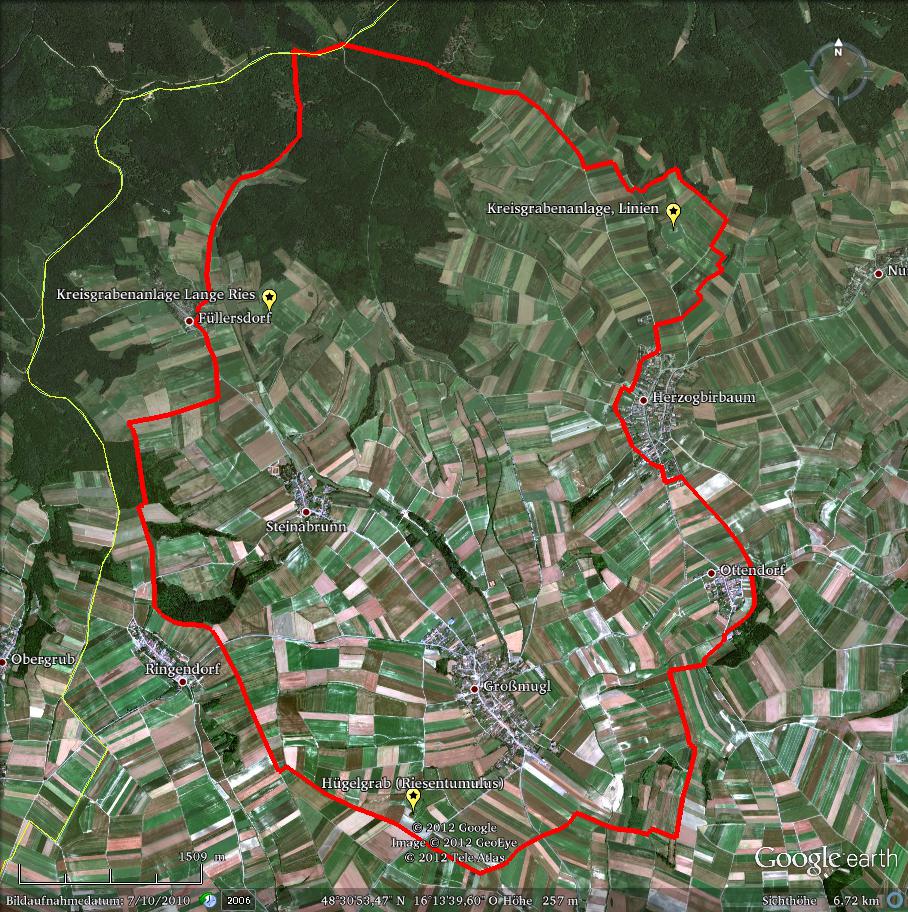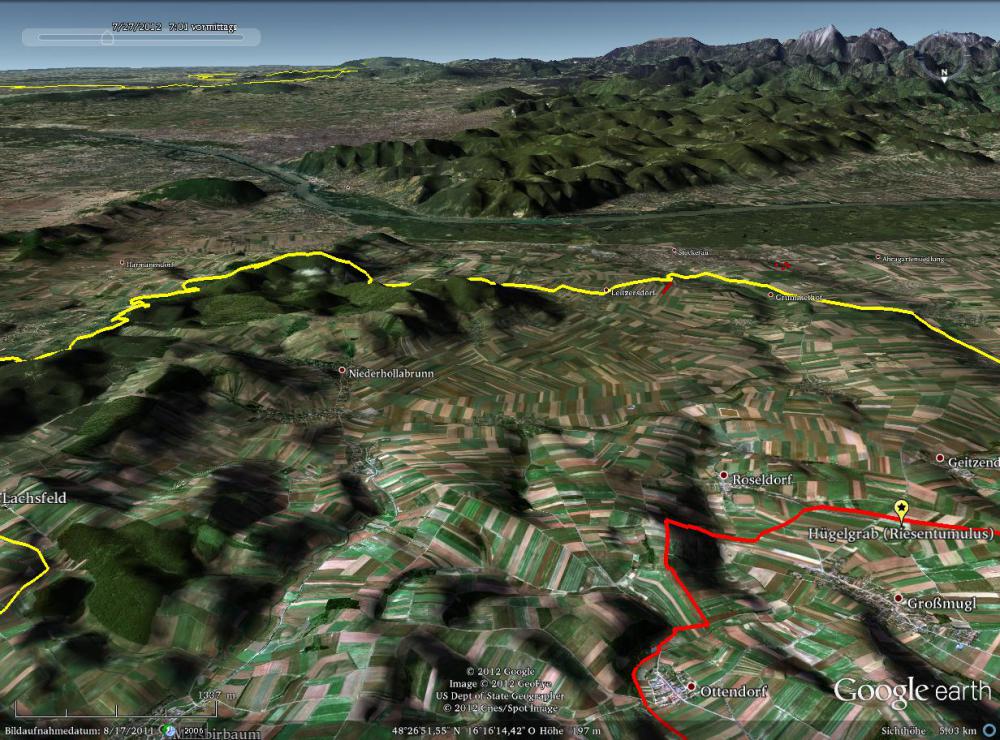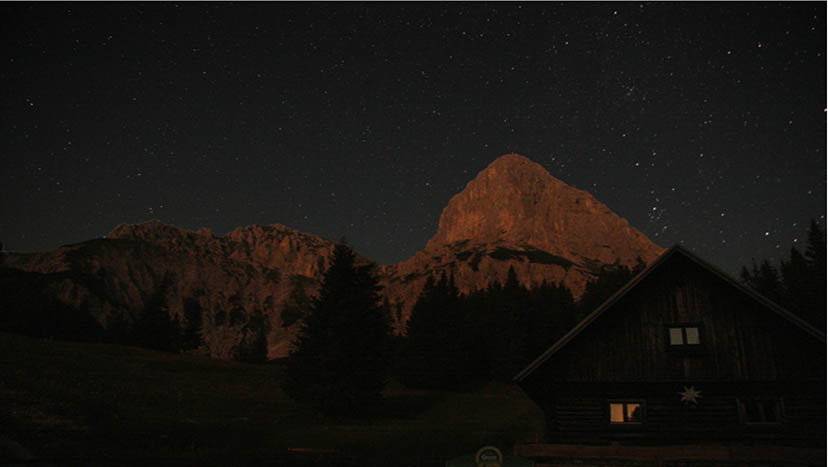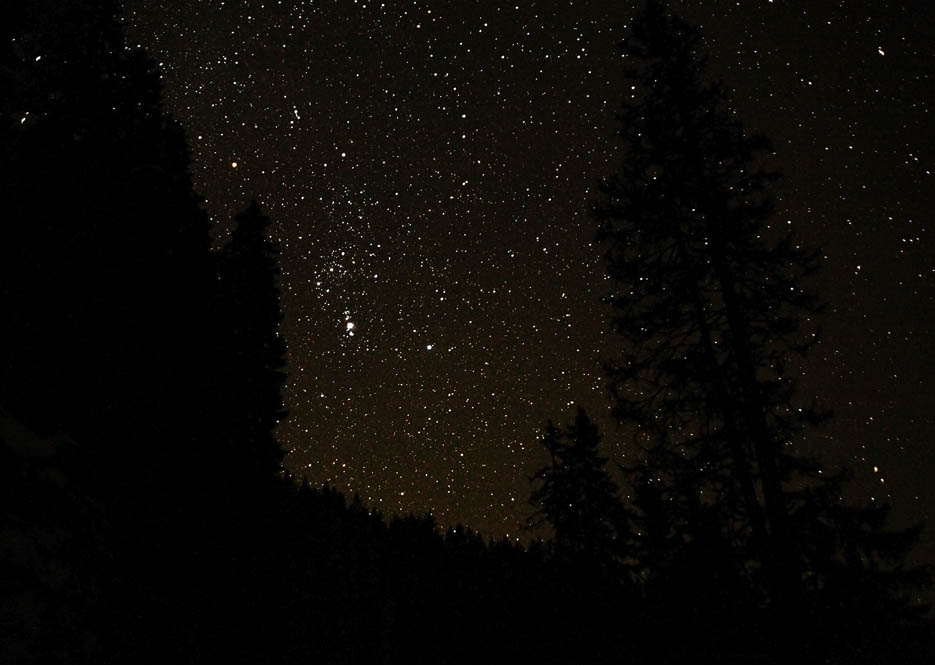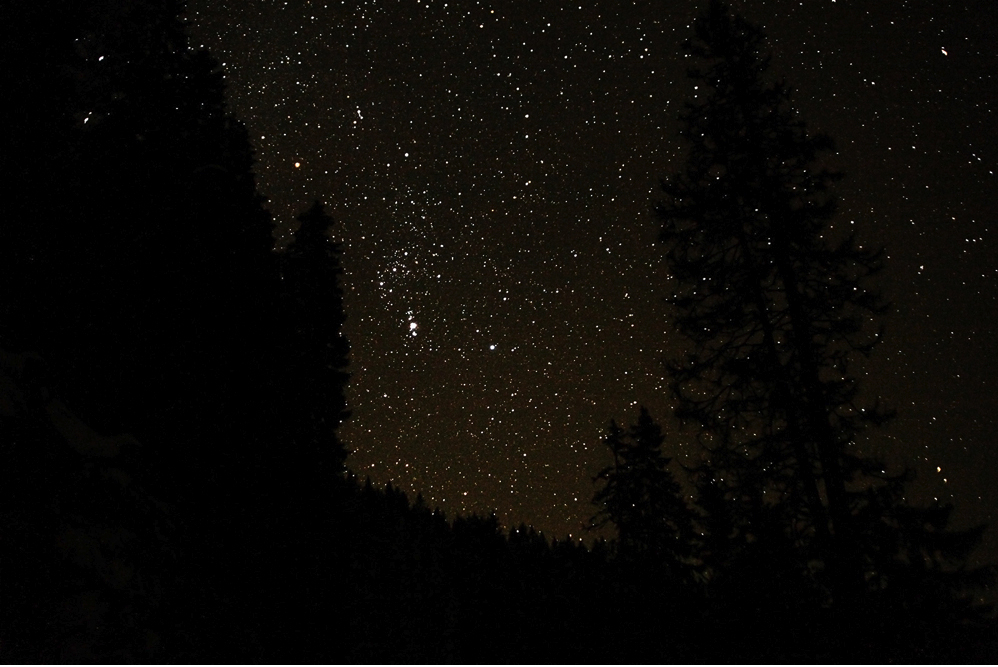
Category of Astronomical Heritage: dark skies
Eastern Alpine and Großmugl starlight areas (multiple locations): Großmugl Starlight Oasis

Identification of the property
Country/State Party
Austria
State/Province/Region
Weinviertel & Korneuburg, Lower Austria
Name
Großmugl Starlight Oasis
(Part of Eastern Alpine and Großmugl Starlight Areas)
Geographical co-ordinates and/or UTM
Latitude 48° 29′ 18″ N, longitude 16° 13′ 23″ E, elevation 265m (Giant tumulus)
Maps and plans,
showing boundaries of property and buffer zone

the Danube is visible at the bottom.

the Alpine east-end in the upper right corner.
The core zone (red line in Figs 2 and 3) has a radius of approximately 3km. It covers an area of about 30 × 40km and is situated 30km NNW of central Vienna (the Danube is visible at the bottom of Fig. 2). It contains some major prehistoric remains—the giant tumulus, the Steinabrunn and Linen circular ditch systems—as well as a number of important sky-observing spots and viewpoints.
The buffer-zone is an area approximately 10km in radius around the giant tumulus at Großmugl. Its border (yellow line in Figs 2 and 3) follows the visible landscape horizon, which is largely shaped by the “inner ring” of a natural light protection system created by the topography. In the directions towards the main Alpine chain, where remote high mountains up to 200 km distant may be seen, the horizon is defined by clearly visible mountain peaks. Towards the north and between the south and south-east (the general direction of Vienna) the border follows mountains or ridges. In other directions the buffer zone extends to hill-crests, forests patches and landscape “divides” in order to include the topographical features that shield the the area against the influx of light (Fig. 2; see also Fig. 5).
The buffer zone, or high-sensitivity zone, will thus include the nearby area that can be directly seen from the core zone, thereby guaranteeing that the effects of air or light pollution will not affect the core zone (cf. Starlight Reserve Concept, p. 20). It also protects the wide and unobstructed views towards and above the horizon and, in particular, ensures full access to the celestial hemisphere. This combination provides protection for the entire night-landscape as seen from the tumulus-area and other viewpoints in the core zone.
In sum, the sky-landscape system of the core-zone is protected by the buffer-zone, which prevents unwanted artificial light intrusion into the site while enabling natural light-flow within it.
Area of property and buffer zone
Core area: approx. 25 km²
Buffer zone: approx. 300 km²
Description
Description of the property
The community of Großmugl is a rural, agricultural area to the NW of Vienna with a particular elevated-plane topography and villages in depressions. An “archaeological landscape” extends around the giant tumulus at its centre (Fig. 4). The main prehistoric remains are:
A full inventory of remains is beyond the scope of this extended case study and necessarily must involve additional archaeological and conservation studies. The open landscape features wide horizons that allow access to the entire firmament (almost a full hemisphere) with a dependable deep Milky Way sky that guarantees the visibility of the Zodiac and Western stellar constellations. The site is naturally protected against artificial light at night by the particular village-structure and a unique natural light-rejection system, consisting of three hill-chains shielding the sky-landscape-system from the city of Vienna with its centre at a distance of 33 km (see Fig. 5). The core zone and a large proportion of the buffer zone constitute a rural area whose starry sky view forms part of its recognised identity (“Großmugl an der Milchstraße”) and values. It comprises a group of small villages keeping the night sky reasonably free from atmospheric and light pollution effects by (at least in part) explicitly realising and following the definition of a Starlight Oasis in the Starlight Reserve Concept, p.13.
Fig. 4 (above right): Prehistoric remains (yellow symbols) in the core zone (marked in red) of the Großmugl Starlight Oasis. They include the Großmugl giant tumulus (lower centre), the Steinabrunn circular ditch system and the Linen ditch and grave-field. Fig. 5 (right): Bird’s eye view (looking south) of the topography at the site that protects the core-zone from the lights of Vienna. The shielding effect against the artificial sky brightening caused by Vienna’s lights and light dome can be imagined by looking at the shadows cast by a low morning Sun. The triple hill chains between the core zone (in red) are visible towards the upper left with the Vienna-basin in the corner. Two of the hill-chains are included in the buffer zone that is outlined in yellow. The village of Großmugl is visible in the lower right corner with the giant tumulus just above it (yellow marker). The conspicuous mountain in the upper right is the Schneeberg (2076m). |
|
History and development
TO BE EDITED BELOW HERE
Human presence in Austria’s Danube area is witnessed by some of humanities’ earliest know pieces of art, probably most famously by the "Venus of Willendorf" with an estimated age of 27 000 years, discovered in 1908 near Willendorf, about 64 km to the south-West of Großmugl.
The region around Großmugl in north-eastern Lower Austria is known as the oldest cultural landscape in Austria with continuous settlement.
The modern Großmugl administrative unit was established in 1970. It is a community in the hill-lands of Lower Austria’s Wine-Quarter with an area of 64.38 km². Ten villages are included as "Katastralgemeinden": Füllersdorf, Geitzendorf, Großmugl, Herzogbirbaum, Nursch, Ottendorf, Ringendorf, Roseldorf, Steinabrunn und Schloss Glaswein.
Großmugl’s importance for prehistoric research has beed long establishedstarting with Matthäus Much, the Nestor of Austrian archaeology. As oneof the first he investigated visible field monuments in Imperial Austria.Already in 1871 he reported the tumuli of the Großmugl area, locally known as the "Leeberge" (Fussnote: With "Lee" from the old High-German (althochdeutsch) "hleo" or "leo" (circonflex, "^" on the "e"s) for grave and "Berge" for mountains). Already in the 19th century abundant finds pointed to the significance of the area for early humanhistory.
During the 6th millennium BCE the first farming culture developed inCentral Europe. Archaeological finds document that the fertile hill-landswith its Loess-soils around Großmugl were a preferred area of settlementsince the beginning of the neolithic era.
Stone tools of all shapes and sizes as well as pieces of ceramic of theLinear Pottery Culture were collected. The finds allowed to documentnumerous settlements of the culture in Großmugl, Herzogbirbaum undRoseldorf. Farm-buildings of the era were huge post-build houses witha length of up to 35 m and more. Animal bones and numerous crops documentfarming and domestication of first goats and sheep followed by cattlethat dominates later settlements.
With the first centuries of the 5th millennium BCE new influences from thelower Danube arrived in Central Europe and significantly changed the the rural cultures. Larger village complexes appear and become centres for a number of smaller settlements. Agriculture and cattlebreeding are practised simultaneously. Aurochs still contributing a significant fraction of the cattle. Settlements of the Lengyel Culture are documented by finds from Großmgl, Herzogbirbaum and Steinabrunn.
Worth mentioning are the monumental buildings of this early culture thatwere erected with large effort 2000 years before Stonehenge and otherhenges. The so called circular ditch systems, that reached their highpoint in the Middle Neolithic are upon the most impressive prehistoricmonuments of Central Europe. Almost all of the 40 circular ditch systemsknown in Austria are located in Lower Austria’s Wine Quarter. One ofthe most impressive examples is located about 1300 m to the North ofSteinabrunn. Built between 4800 and 4500 BCE the maximum diameters of its inner and outer ditches are 88 and 58 m, respectively. There function is still unclear.
In the Early Bronze Age, 20th to 16th century BCE, a metal processing centre apparently existed in the Großmugl area. Bronze was predominantlytraded in the form of Ingot torc in the Moravian-Lower-Austrian borderregion. Two depots have been found in Geitzendorf. In 1910 more then61 Ignot torcs (ring-shaped bars) were dug up on the Geitzendorf fields, 39 in 1949 as well as six arm-spirals, and an another Ignot torc in 1979. Further depots surfaced in Senning and Sirndorf. In Großmuglfour of the typical crouching-graves (Hockergräber) of the era were found as well a ceramic depot and four settlement-pits (Siedlungsgruben)that belong to an extended early bronze age settlement. More settlementsare known in Füllersdorf, Herzogbirbaum, Steinabrunn and Roseldorf.
In 2008/2009 a burial ground was discovered in Geitzendorf. One of thefifteen graves, that could be classified as the classical stage BzA2 ofthe Aunjetitzer Culture, contained an archaeological highlight that ledto worldwide attention: the first evidence of a female metal workerin early bronze age. In the female’s grave unusual grave goods were found together with costume and ceramic remains. They are stone tools: an anvil and a hammer as well as hit-stones typical for metal-processing, in particular the fabrication of jewellery. This unique find sheds newlight on women in the bronze age as the dominant opinion holds metalprocessing as a male domain. Apparently that is not true a least fora goldsmith. A further surprise was a remarkable multiple burial in the early bronze age "Linen" circular ditch system in Herzogirbaum.While clearly Aunjetitzer this burial in a ditch system is exceptional.
In the middle Bronze Age (16th to 14th century BCE) the tumulus cultureshaped the area from eastern France to Western Hungaria. Presumably theprivilege of an elite, the graves contain many heavy arm-rings and elaborate necklaces typical for the women of the epoch, while men wereequipped with weaponry as axes and daggers. Many impulses are alreadyapparent from the Minoic-Mycenic cultures of the Aegean and left tracesin Großmugl. In 1966/67 spectacular vessel depots were uncovered featuring a double handled amphora, a giant vessel with "Kornstrich"decoration and other pottery showing the artistic richness of the era.
With the turn of the 14th to the 13th century BCE a new cultural complex spread in Central Europe characterised by their practise to cremate corpses and bury urns. The burial grounds of this "Urnfield" culture,usually outside town and often across a river, left four gravesin the old Großmugl brickyard. These important finds discovered in 1939contained numerous bronzes and a famous brooche/fibula that lead to the"Großmugl type" entering the literature. Numerous finds and excavationsfrom the era are known in Herzogbirbaum und Steinabrunn.
The Urnfield culture also left two grape-seeds dated 992-810 BCEfound in Stillfried an der March, east of Großmugl in the Wine-Quarter.They are among the oldest documents for cultured wine in Central Europe.Today the Wine Quarter with 14 000 hectars of vineyards is thelargest wine producing region in Austria.
For Großmugl the most evident and important prehistoric era is the Hallstatt-period (the older iron age, 8th to 5th century BCE). Lessthen a kilometer from the last sheds of the village, the Hallstatt-culture’s largest tumulus in Central Europe rises 16m above the landscape, ultimately name-giving to the village. In 1293 it is first mentioned in written as "Grassemugel". The name beeing composed from the slavian "krasa" (beautiful) and "mogyla" (bourial mound). The tumuls is untouched and has never been scientifically investigated.
A today much smaller tumulus in the immediate vicinity, 50 m to the NW of the giant and locally known as the "Grave of the queen" wasexcavated in 1950 to 1956. Remains of a wooden tomb-chamber und numerous mighty ceramic vessels were found but their state of conservationmade scientific studies impossible. A few items were restored includingparts of a horse with a rider. In the immediate vicinity of the twotumuli further but flattened tumuli were discovered on aerial fotographs.
Further finding locations of the Hallstatt-culture occur in numbers aroundGroßmugl. In particular worth mentioning is the "Todtenweg" (way of the deaths). Excavations in 1938/39 and 1989 to 1994 uncovered large settlementareas. In a pit excavated in 1989 a fire place and aligned loom-weightsthat point to a weaving/woven hut. Abundant finds including a twin-loopedbow brooch lead to a Kalenderberg classification with ceramics allowingto assume an older Hallstatt (C2) age-classification.
The younger iron age (5th century BCE to 0) is shaped by the Latène-Culturethat is Celtic according to antique sources. Großmugl brought potsherdsof the typical graphite-clay-ceramics to light. Settlements are knownin Großmugl, Herzogbirbaum and Roseldorf. The duke-court "FürstensitzKeltenstadt Sandberg" in the near Schmiedatal-Pulkautal region, 27km to the NW is the largest known Celtic settlement in Austria. About 1500gold and silver coins make the site the coin-richest known in Austriafor the celtic era and Austria’s oldest mint.
Germanic settlement in the 1st and 2nd century focused in the centraland eastern Wine Quarter and lead to dense settling north of the Danube in Lower Austria. But only stray finds from the Roman imperial time(1st to 4th century) are known from Großmugl.
The first population-groups from the late antique middle ages (5th to10th century) can be demonstrated by burial fields from the 9th century.While they offer a certain perspective on the intensity of Slavicsettling, little is known about the live in Slavic settlements, however, e.g. a socket-lance-head (Tüllenlanzenspitze) from Großmugl is known.
Christianization of the Danube area in the 8th century proceeded from Passau under Karl the Great with the large mission of the Wine Quarterstarting in 1000 to 1150. Clearings resumed with the population growth in the Middle Ages to gain further farmland. Drainage of thelandscape then characterised by abundant standing water as moors and wetlands started. However, large scale river and beck-regulation only started in the 19th and 20th century.
Lower Austria early developed an awareness of its prehistoric history.In 1970 the Museum of Early History was opened in the castle of Asparn an der Zaya, 22 km NE of Großmugl. It is upon the most importantof its kind in Europe. An archaeological open air exhibition ground wasset up that features settlement-objects from the Stone Age to theIron Age that were reconstructed at 1:1 scale following archaeologicalevidence as far as possible. Since 2014 early and medieval archaeologicalobject are presented leading to a coverage of 40 000 years from the Stone Age to early medieval times.
The Großmugl Oasis is a generic prototype for a ’Starlight Oasis‘. It was initiated at an existing observing site of the Kuffner-Sternwartesociety following the adoption in 2007 of the La Palma Declaration for the Right to Starlight by the society and the community of Großmugl.
While the area has been one of intense agricultural use and forestryduring all of the many millennia, one of Europe’s first bat censuses wascompleted in Großmugl and six Natura 2000 areas are now established inthe Wine Quarter, one overlapping with the proposed buffer zone.
Justification for inscription
Comparative analysis
The combination sky-prehistory-history-city is exceptional and the comparative analysis must start from the individual factors contributing to the value. (1) The sky is rural, guaranteeing an impressive Milky Way but there are better sites for an astronomical sky of professional quality or very faint visual objects. However, the sky is outstanding if not unique at such proximity to a city with a metropolitan area population of about 2.4 Million people. Usually at other cities and in other directions from Vienna much larger distances (by an estimated factor of 2-5) are necessary for a sky and night-time environment of the same quality. (2) the significant archaeological remains are conserved with their authentic night-time appearance. The giant tumulus for example is the largest or one of the largest in central Europe and name-giving to the village and the community of Großmugl. However it is certainly less outstanding than Stonehenge is for megalithic sites. (3) the proximity to the city of Vienna and its role in the Renaissance of astronomy as well as the location in Kepler’s sphere of action makes it an ideal location for the conservation of an authentic example and a monument of science for the sky as a factual basis of the rebirth of astronomy in Europe.
Good and complete visibility of the entire firmament is an important factor for an authentic example and this value is multiplied when considering the close proximity to the Vienna heritage site. Vienna being at the origins of the rebuilding of the astronomical basis by the “Viennese school” around Gmunden, Peuerbach and Regiomontanus.
For the Renaissance-astronomy-sky one of the related city-observatories would be a reference but above and around most cities essentially all stars are gone, not to mention the fainter zodiacal constellations as Pisces. The Großmugl site offers proximity to Vienna as a place of authentic astronomical observations. For example sites as Pisa, Venice, Padova and Firence are much more compromised by the light-situation in the Po-plane. Paris and other present metropolitan areas central to Renaissance astronomy are hard to imagine to provide an intact zodiacal constellation within a hundred km from their Ôö¼┬ícentres.
The Steinabrunn “Lange Ries” circular ditch system (Zotti, Neubauer, Schneidhofer and Totschnig 2009) has a lower credibility class 2 (Zotti and Neubauer in press) for astronomical connections. But it reminds that in the Großmugl sky-landscape-system claimed astronomical alignments can be judged with the authentic night-sky above. In any case the night-time setting of the giant tumulus and the “Linen” circular ditch system in Herzogbirbaum can be seen in an authentic way because the night-sky and the night-light is intact.
It is at least very difficult to find a similar sky quality above any comparable – say Hallstatt or context-related neolithic – archaeological site of comparable importance. The Hallstatt-site would be a candidate for similar sky quality above a world-heritage site with higher prehistoric importance as it is name-giving for the entire epoch, but due to its relatively secluded Alpine location the sky there is compromised in viewing the firmament completely by the narrow valley landscape – the village leaning on a steep mountain. While this certainly contributes to the aesthetic richness of the site it is a compromise for the sky as monument of an astronomical era or orientations that certainly benefit from optimal – i.e. full sky – access.
There is little known about large scale distribution of sky brightness due to light-pollution around cities with full coverage in all directions but a pioneering study has been recently published for the city of Perth, Western Australia (Biggs et al 2012). At 30 km from the central business district the mapping shows 20.5 mag/”² in the least light-poluted northeastern direction. At the Großmugl core 21.15 mag/”² were measured with an SQM (The Unihedron sky quality meter, measuring sky brightness in an instrumental photometric system that is oriented towards but not equal to astronomical visual magnitudes, see Biggs et al. for discussion in the present context.). During a Lightmeter-mapping campaign of the Großmugl buffer-zone, cf. Figure 5, SQM measurements throughout the buffer scattered around 21 mag/”² for almost the entire buffer and all distances larger then 25 km from the historic centre of Vienna. Considering that both – the Großmugl and the Perth – measurements are done in the SQM’s instrumental system and an instrumental error of the SQM of about 0.1, that implies a difference of at least 0.5 magnitudes near the zenith. That means about 0.5 magnitudes from a natural sky to Großmugl and another 0.5 to the Perth optimum direction at the same distance from the city-centre. Incidentally the darkest skies near Perth are also located behind a mountain range. Keeping in mind the differences in climate and consequently extinction natural variability, the fact that Perth is one of the most isolated cities in the world and thus no contribution from “neighbouring” cities, the reduced airglow in Perth (latitude 32 S compared to 48 N – the difference should be enhanced for magnetic latitude) and the fact that measurements in Perth were taken at solar minimum, the difference is a very robust half magnitude. This is in addition to the fact that the Vienna metro population is 2.4 Mio compared to Perth with 1.7 Mio. And the sea-side extinction (not measured in the Perth study) is expected to decrease the natural sky brightness in low light-pollution environments compared to the 300 m elevated continental Großmugl site.
The astronomical value: night-sky quality at urban proximity
A starlight oasis is constituted by a combination of night-sky quality and ease of human accessibility, mostly the proximity to densely populated areas. The key astronomical value of the Großmugl Oasis is to maximise sky quality and proximity.
Key indicators of night-sky quality are:
1. the brightness of the location (illumination excess by light pollution threatening the integrity of sky and landscape),
2. the irradiance (energy flux per unit area in our case on the ground and through a horizontal surface), relevant for the environment, flora, fauna (due to our photometric brightness concept being dominated by technical convention incorporated into the SI-candela/Lux system that is relating to human daytime-vision (photopic mode of the eye) the irradiance is also a relevant quantity for humans in particularly at night when their perception is naturally in mesopic or scotopic mode. Furthermore the human circadian internal clock is largely synchronized by the blue-sensitive photosensitive, retinal ganglion cells that control Melatonin production. A similar issue and also a consequence of the narrow definition of the Lux is that is does not include UV and thus a UV-index is absolutely necessary for medical reasons during daytime) and (micro-)climate,
3. the night sky-emission – natural and artificial, often measured towards the zenith (light emission per unit area, more precisely unit solid-angle, in astronomy often measured relative to stars and there traditional magnitude and given in magnitudes per square arc-second (mag/arcsec²))
4. the emission of artificial light from the area towards the zenith as seen from satellites, as proxy for the artificial light input into the atmosphere (note that this quantity actually uses the fraction of the light that escapes directly to space and thus is not a factor degrading the sky quality for an observer on the ground that is presumably mostly effected by light emitted near the horizontal)
Proximity as far as artificial sky brightness is concerned is usually discussed in the context of empirical rules of thumb based on city-population and distance (e.g. Walker’s law derived for Californian cities in the 1980s). Typically 100 km are a plausible distance to get to a fairly good sky (magnitude 6 for a sky with a conspicuous milky way and thousands of stars, magnitude 7 would be a near natural sky with about factor three more stars/less sky brightness) for a city population of a million. The population of Vienna is about 1.7 Mio people and the 9th largest for cities in the European Union. About 2.4 Million people life in the metropolitan area.
Großmugl at 33 km from the city centre provides a weather-robust conspicuous and impressive Milky Way. A visual limiting magnitude beyond 6, an often quoted value for the limits of visibility for naked eye stars is typical for moonless nights. Hand-held SQM-measurements are at 21.15 mag/”² in the core and scatter around 21 mag/”² through most of the buffer-zone. Observatory skies are measured around 21.6 with significant natural variations (Patat 2004). The sky quality statistics for one year as derived from continuous measurements at every second is discussed in the “status of conservation” section.
Comparative approach to cultural state of conservation – what are well preserved “nocturnal remains”?
“Relatively” dark starlight areas – Zodiac and Milky-Way as pragmatic references
The Starlight Reserve document gives the skies of inhabited areas, of small villages reasonably free from light pollution as a prototype for a Starlight Oasis (see Starlight Reserve Concept p. 13-15). That implies access to the Milky Way in the better cases and roughly reflects the pre-light-pollution situation of the 1960s when the Milky Way still could be seen from cities with more than a Million inhabitants.
We will therefore assume a conspicuous appearance of the Milky Way and the visibility of the classical constellations including the Zodiac as the typical context for an intact night-time cultural context of a site (this results in requiring a sky with a visual limiting magnitude of 5 or higher. Limiting factors are the Milky Way and faint constellations as Pisces, Libra, Ursa Minor where key stars exceed 4.5 mag). To visualise what this means we note that this essentially results in a naked-eye sky showing all the types of phenomena integrated into the state-of-the-art sky-simulator “Stellarium” (this does not mean all the stars or all the nebula in the Stellarium software because extensive catalogues are used to support zooming, telescopic views etc., but it is a good reference for what is a simulated credibly sky in the sky-simulator that is most popular also under amateur and professional astronomers and educators). Stellarium – as the sky in a Starlight Oasis – is not complete (incompleteness means absence of very low surface brightness naked eye phenomena: (1) seasonally the Zodiacal Light, (2) the Zodiacal Band, (3) the Gegenschein, (4) some extended nebular structures, e.g. the Galaxy M33 in Triangulum but not M31 in Andromeda) but it shows a practical essence of what is generally needed for educational and cultural purposes.
Integrity and/or authenticity
Median sky conditions show an impressive Milky Way – dependable visual limiting magnitude above 6 mag - approaching natural conditions under favourable weather situations, though light pollution from Vienna is noticeable (see sky-monitoring measurements and analysis).
The site is developed around an intact and authentic, unopened giant tumulus, see archaeology of a landscape for more on the inventory of pre-historic remains and their description. A complete study of the integrity and authenticity of the non-astronomical inventory is beyond this extended case-study and has to be performed in an interdisciplinary way towards a complete assessment.
Following the discussion of the integrity and authenticity towards the base-values we make an effort to show the possible connections and relations to astronomically determined environmental factors in a broad sense with potential additional cultural, archaeological and science-historical values.
Nighttime integrity and the “end of night”
One way to look at the value of an intact night-sky for world heritage in our context is to look at the challenges posed to the integrity and authenticity of existing sites by the relatively recent dramatical rise of artificial sky brightening connected to light pollution. While a relatively intact night was self-evident even long after astronomers first noted light pollution in the 19th century, it is now evident that the night-time situation has significantly changed the appearance of many world heritage sites at night. Part of this may even come from efforts to enhance the appearance of the heritage itself – by lighting the site at night. At least partly this was necessary to counteract the trend of sites disappearing from the skyline or landscapes due to the ever increasing urban night-time light-levels and the conversely appearing and concurrently spreading “dark-corners" (a consequence of high luminous density emitted by artificial light creating high contrast “light-spots” causing the pupila to shrink an “stop down” the eye’s sensitivity in adjacent low intensity parts of the image) and flat perspectives that are created as a side effect.
Thus we approach the question of evaluating the comparative increase in evidence of the value of sites with a good night sky that is concurrent with the spreading of the use of artificial light at night by following the proven path of getting a hint for understanding a value by looking at how it diminishes and what might have been lost at existing sites.
Similar to the situation of living species facing extinction, the value of the now almost lost authentic night-time culture of many areas and periods rises with the diminishing asset. Given their proximity to the Großmugl site that we discuss here we use the two world heritage sites in Vienna: its historic centre and the Schönbrunn Imperial Castle to illustrate what integrity and authenticity, and their loss, may mean at night in a cultural environment.
A loss of integrity – half the time for most of things?
Light is an integral part of access to any artefact, as our visual system is a key pathway towards “grasping” nature and human artefacts – our visual door of perception is comparatively wide. Thus light is often the primary medium that physically connects the human with its tangible heritage. By modulating this connection it is a key factor in authenticity whenever seeing plays a role.
Protecting the integrity and authenticity of the night time environment may well be upon the most outstanding challenges of world heritage efforts in populated area (an estimated 20% of the Earth’s population have no access to electric light, whereas billions of people face the consequences of its intense use in urban areas). A Starlight Oasis is the instrument for that.
The integrity of the night-view and night-scape and the authenticity of night-culture is presently a general challenge. As it is the case for many other sites, there is little perspective to see the buildings of the heritage site of the historic centre of Vienna in the authentic night-light of the time when most of them were built. Until approximately the enlightenment (cf.: regularly scheduled public lights: Paris 1667, Amsterdam 1669, Haag 1673, Hamburg 1675, Vienna 1687, Berlin 1682, London 1736 (Hess 1902); 1884 first electric street-lights on continental Europe in Steyr/Austria) landscapes, buildings, sacral and representational as well as monuments were seen in starshine and moonshine. So evident for the contemporary as is the daylight view for us now. These night-time views certainly were key to if not the cause of the link for festivities connected to the moon. Like for the mayors until the mid of the 19th century, that switched on artificial lighting only in dark moonless nights it was obvious that there is enough light at night with the moon up or outside the long winter nights of central and northern Europe.
Yet today it is impossible to see Schönbrunn-castle or the St.Stephens cathedral in the historic centre of Vienna as the contemporaries could for about half of the time. Actually much of the representative “luxury” of such sites may well be related to the particularities of night-culture.
To illustrate that we briefly move from one “enlightened” court to the other, the one of Friedrich II, in Potsdam, (Figure 6) in a period of repeated warfare between them. In “enlightened” courts the ultimate luxury was the crown-light (candelabrum), one (not the one in Figure 6) in use by the King who enjoyed dining with Voltaire cost the equivalent of 5 annual salaries of his court musician Karl Phillip Emanuel Bach (a typical of 3000 Taler for a deluxe candelabrum of the “Neue Palais” compared to 300 Taler Jahresgehalt für Karl-Phillip-Emanuel Bach candelabrum (heute 500 000 €) candelabrum for 6000 Taler were offered). There is now considerable evidence that the extension of activity into the night by itself was a highly paid privilege and constituted a key element of the ultimate luxury. Being able to afford to sleep during the day and sustain night-time activity against the classical dangers of darkness was a very high, maybe one of the ultimate social privileges.
******* INSERT FIGURE 6 HERE *******
A surprise came to technicians and custodians of the “Stiftung Preussischer Schlösser and Gedenkstätten” when with large effort – candles are not the best friends of fire-chiefs in precious castles - they reproduced the 18th century light situation of the flute-playing monarch in the Konzertzimmer of the Neue Palais at Potsdam: 5 Lux (measurements gave 4-6 Lux as typical for the room, a little more dirctly under the candelabrum) at most was the shocking result, and a very “dim” impression for all involved, yet they discovered the fascinating way the room came to live with all the candles in all the mirrors and the crown-light creating a “Christmas tree” atmosphere. Of course unlike in the old days the people came into the royal light not from a dark park outside, not through a sequence of court-rooms with slowly increasing candle-contingent and smaller crown-lights, they came from rooms housing a couple of modern ceiling floodlights to show all the Pracht/splendor as close to the daylight view as present lighting technology can provide. Certainly what was also lost is the “art of seeing” at night – we are culturally night-blind.
Night-time integrity and Night-time authenticity
We return to the outside and back to Schönbrunn castle. In a way the Großmugl Starlight Oasis can be viewed as also protecting a night-time part of the nearby world heritage sites of the city of Vienna and the imperial castle at Schönbrunn. For the latter a significant effort was made to reconstruct the authentic daytime view as part of the integrity of the façade not to the least because of the “Schönbrunn-yellow” colour that was “iconic” in the Austro-Hungarian empire. But while the daytime colour now delivers an authentic framework for the representation-ensemble at Schönbrunn the night-time colours and appearance are modern in many aspects of the word. The Gloriette decoration building will not appear as a moon-lit accent in the imperial gardens in pale moonlight as viewed from a candle-lit mirror ball-room, it has to fight for contrast with modern ball-room illumination, a fight for the attention of the indoor viewer that can only by won using lighting technology on the megawatt scale.
All this is clear evidence that night-time authenticity in general should go on a red list of culture facing extinction in most places relevant for world heritage.
It illustrates what we are loosing at a moment when the (integrity and authenticity of) night-culture is mostly neglected and the apparatus for a scientific description is in status nascendi. Even the expert is in difficulty to make progress in intellectually grasping the masterpiece without the original at hand, without an authentic perspective.
The Starlight Oasis – a place where people live with a relatively good sky – provides a conservation tool for night views, night-scape and night culture: I will progress with putting together astronomical/physical references that are necessary for keeping the light of a site intact (note that the situation is “naturally” kept intact during daylight – except for cases of severe air-pollution – because the sun still dominates the outdoor daylight by orders of magnitude and we do not have at hand the technical ability to change that significantly. Even in special set-ups like a theatre or film studio this is still a challenge). During the night-time we de-facto have the technical means to fully control the light, the contrast and the colours of anything. So far this opportunity has often been used to change the night-light of world heritage sites in a way that arguably compromised night-time integrity and night-time authenticity.
In summary and emphasising the return to the positive value of a moderately intact night-time environment, from the absence of a problem to the presence of a value/asset, to quantify what is a valuable “night-sky-ruin” if you like: a comparatively well preserved night-sky provides not only the astronomical authenticity of a site – including a physical context for astronomical narration – but also the upper half of landscape integrity, the integrity of the night-light and in consequence the integrity of the night-time environment (e.g. by allowing the original species to sustain life and exhibiting their authentic behaviour) and thus the basis of an authentic heritage of natural and cultural monuments and artefacts – indoor and outdoors. When the curator’s effort to show pieces of art by bringing the daylight into the exhibition is action towards the goal of authenticity, the Starlight Oasis is the tool for similar efforts at night. It brings the night light to our heritage in places where people still live and conserves the night-time authenticity.
In conclusion, a site that preserves the integrity of nigh-time phenomena in an inhabited area is the only way to preserve culture at night in an authentic way, thus the role of a Starlight Oasis reaches far beyond the gateway to the skies and the astronomical heritage (beyond its manifestation as modern ‘rational’ science (and arguably in that case also), practices related to astronomy are inextricably linked to broader assemblages of cultural activities. It follows that the material heritage of astronomy in the form of artefacts and constructions will often be deeply integrated within material heritage of a broader nature and significance. The Viña del Cerro site in Chile, for example, provides an excellent example of astronomy in a broader, integrated context of resource exploitation, sacred places, calendar and landscape).
The night-sky of a site as a tool of visual astronomy and a monument of science
An important part of science is the concept of evaluating the quality of a theory (or falsifying a competing theory) by comparing with “measurements” that are based on a reality – an objective world or “world one” in the Popperian context - that can be measured. Measuring usually means to quantify with a given “measure” or “unit” or “standard” following rules of measurement or measurement concepts. The resulting “number” in terms of the “unit” then allows to connect to a mathematical language that is constituting/system-forming in particular for astronomy. That method has been the epistemological model for a dominating stream in many sciences.
While records of measurement are a key practical element, they are not the primary source for the progress ranking in the competition of theories, because they may contain not only errors but hidden often implicit assumptions made by the “observer” during the measurement process. They may also lack contingential (german: kontingent (adj.)) information (say the air temperature when the measurement was taken) that turn out to be necessary to evaluate the number relevant for the comparison with the theory and to decide its correctness or passing or failing a test in the language of critical rationalism.
The “physical basis, the real system” is an essential part in the authenticity of scientific culture as it is the ultimate reference for correctness. It is the authentic original of the phenomenon explained by a theory for its claimed “domain of applicability / domain of validity” (e.g. as Newtonian mechanics with a validity in weak gravity fields and for speeds that are small with respect to light). The very concept of “truth” as a correspondence of theoretical results to “facts” relies on the availability of the reality-reference.
An illustrative example are units and standards used in measurements. To get a representation for the unit a standard has to be measured. The most famous one may be the meter-prototype (mètre des archives, Urmeter). This is the factual basis of the meter. To determine a distance in meters, in a way that other people can check, first the prototype has to be measured an then the distance in question. Thus the prototype is necessary as a factual basis of the method. If the method of measurement changes, usually in search for better accuracy, the prototype is remeasured and so on. While the meter is now realised by a time-interval and the speed of light, the most striking example in our context is the kilogram prototype for mass that is still a carefully kept piece of metal near Paris. It is the factual basis of mass in our measurement system.
For the astronomical systems as the reference-systems for motion, Earth-rotation or solar-system relations the standard is what is in the sky. As an example the coordinated universal time is measured with high-accuracy clocks but carefully adjusted to the Earth’s rotation by monitoring it relative to astronomical objects. This is one “applied” example of the central role of the factual basis in the astronomy and science in general.
We discuss the “sky” here as a “fact harvesting field” that constitutes the “reality” that is the basis of the central progress paradigm of science: the factual reference. A theory is a better theory if it has a better correspondence with measurements i.e. derived numbers from a measurement practice. That measurement practice operates on an agglomerate of natural phenomena that is approached in a particular way. These “measurement conventions” are integral part of deriving a scientific result and are adapted to the local situation by separating “contingential” information that allow certain approximation to be applied to arrive at the measurement numbers (e.g. in Babylonian astronomy and beyond the renaissance atmospheric refraction and extinction were ignored, though Ptolemy was aware of the “foggy” conditions of the sky near the horizon.For example to obtain a position of a celestial body it needs to exceed a particular contrast with respect to the sky in the background. That stars are not seen during the day is a consequence of the fact that the sky is too bright during daytime. Similarly the fact that the stars and planets relevant for forming the fact-basis for the Western Renaissance Astronomy are visible and thus can be used in the “truth” system of science depends entirely on the sky quality. The cornerstone sky-features for Kepler’s laws are for example the stars of the ecliptic band to obtain, as Tycho did, high precision planetary positions relative to them and to allow the respective coordinate systems to be built with their help in particular the foundations of a good equinox, and last but not least planet visibility).
******* INSERT FIGURE 7 HERE *******
For the astronomical renaissance the sky necessary for authentic science is in practice a sky showing planets, their visibility phenomena and the respective reference stars. The easiest way to quantify that as a criterion of authenticity for this body of science is to use Tycho’s catalogue or method and require roughly stars down to magnitude six to be visible with the naked eye. That again brings us to the Milky-Way sky of a Starlight Oasis.
For ancient Egypt the authentic sky would be one at least showing the stars forming the Decans joined with a large gap concerning importance the planets and the Egyptian and Hellenistic constellations.
For Babylonian astronomy a sky constituting the “fact-basis” would be one preserving the respective constellations, normal stars, ziqpu stars and again the planets as well as the cornerstone rise-setting phenomena for stars contained in the body of cuneiform texts. Certainly this would also serve the goal of conserving the authentic Zodiac as a landmark of Western (astronomical) culture.
An authentic appearance of the moon is assumed to be self-evident here but issues might concern the “first light” under some circumstances and city light levels recently lead to the loss of the authentic appearance of total lunar eclipses. However, given the fast growth in light-levels at night it is not unthinkable that we might lose the moon for certain lunar-phases in urban areas unless they are protected.
The question of authenticity may arise if Starlight Oasis are used as the monuments for a scientific sky of an epoch somewhat outside the historic centres of that particular epoch, the historic city of Vienna, say for the Großmugl case. Evaluation of that issue rests on what displacement renders a sky not characteristic for its use. As the changes are overall minor on the naked-eye scale we may take Ptolemy’s climates as a reference for sky-locality classification. A more quantitative way would be to compare the typical accuracy of archaeoastronomical alignments that is for a number of reasons (apart from weathering and other conservations issues that includes long-term (secular) changes in the Earth-Moon system e.g. on the tilt of the Earth axis and the star-ecliptic relation due to precession) on the few geographic degrees scale, just as a starting point. If we take the Keplerian-sky as one spanning in spread the localities in Kepler’s biography we also arrive at a spread of a few degrees in latitude and longitude for the authentic range of “Kepler-skies” (Kepler’s home-skies: Weil, 48°45’ N, Tübingen 48°31’ N, Graz 47°04’ N, Prague 50°05’ N, Linz, 48°18’ N, Sagan 51°37’ N, Regensburg 49°01’ N). Thus we consider a sky authentic for a particular location or epoch as long as it is a few geographical degrees within that locations or historic centres of the epoch, respectively and consequently the sky (not the landscape horizon) of a Starlight Oasis is considered authentic for distances on the order of two geographical degrees or ~250 km. This gives an interesting perspective of globally conserving an authentic sky of all human cultures and epochs by a network of Starlight-Oasis separated by approximately 500 – 1000 km.
In summary, the relatively dark sky of the Großmugl Starlight Oasis (and possible others) conserves that factual basis of the intangible part of the scientific tradition and constitutes a key element of its truth- and progress-concepts. While from a positivistic point of view the factual basis is a/the reality, from the point of view of other schools of thought it is a construction or narration, but undisputed is its role as a, if not the most important component of the scientific method. Protecting this component of the method in the case of astronomy means protecting its origins. The particularities of the night-sky at a given location and the authentic situation for an epoch make it a monument of science for the scientific tradition at the site. This complements and completes the heritage of instruments, which was often the human eye alone until the telescopic revolution changed everything.
The authentic sky of an epoch-
Starlight Oases supporting the culture of the night and authenticity of heritage sites
While the progress on science heritage is a key objective of the thematic study, the night-time environment or night-time landscape constitutes a part of the integrity and authenticity of many sites. While it is a standard conservation issue to protect the landscape and setting of a site under pressure by human activities (building pressure, deforestation) it is much less common to consider the pressures on the sky. That is mainly because until relatively recently we did not have the technology or it was much less practical to modify the sky compared to the landscape. Humanity developed abilities to manipulate stones, building-blocks or the shape of a landscape but not the sky. With industrialisation that changed dramatically and even more so with the availability of electric light and in particular the availability of the energy necessary to change the sky.
Western natural-light night-time culture essentially started to be modified with the introduction of public urban light (starting with Paris 1625). It was challenged by introduction of electric street-lights concurrent with industrialisation (in continental Europe, Steyr 1884) and started to rapidly disappear with the energy-boom of the second half of the 20th century. As a natural consequence and concurrently professional activities in natural night light largely moved to the remote astronomical mountain-observatories as the only remaining unlit sites. Professional practice in near natural night conditions was confined to navigation (sea and air) where the human vision still provided unparalleled quality in orientation with a strong trend in special (military) night-time tasks being increasingly performed with vision enhancement systems that brought an end to professional natural human night-time orientation once image-intensifier tubes and infra-red-equipment became more practical and often superior for particular tasks as search and rescue operation than human night-sight. For technical and partly traditional reasons astronomical use of the eye partly (in particular applications where integration techniques could not be used and rapid response was needed as the “guiding” of the telescopes by a human operator during long-time exposures on photographic plates) continued in astronomy until the 1970s because the eye still being superior on certain time-scales and for certain tasks.
While many recreational cultural activities dealt with the night-time by using artificial light for daytime extension, astronomy by construction remained the guardian of western night culture.
A Starlight Oasis, including the one discussed here, is not able to satisfy the highest standards of telescopic astronomy that can be better served by changing the cultural context and moving to a remote site. However a relatively natural night-sky can preserve the most important astronomical features – we restrict ourselves to include the classical constellations in particular the Zodiac and the Milky Way – and preserve the cultural, natural and geographic context.
The cultural context is obviously important since a desert’s sky cannot replace the authentic overall setting of a night-time Renaissance city. The natural context determines for example the seasonal behaviour of plants and birds (singing times and -seasons) by changing twilight patterns and in case of migrating birds appropriate navigation-stars.
The geographical context has to be considered in addition to the relation with localities of culture and landscape and dependence of day/night twilight and setting phenomena on latitude, that were discussed above. If tidal-phases or other phenomena that break the astronomic rotation-symmetry, play a role geographical longitude is an issue.
To illustrate that clearly: culture under the sky cannot generally be preserved in an authentic way on a tropical island or a west-continental desert that has the perfect conditions for telescopic astronomy. While one of the highlights of astronomical perfection in measurement and the development of science and technology these places are a mere drop in the ocean of the night-time culture of humanity.
A northern polar sky with its polar nights, seemingly endless twilights, the midsummer brightness and the often aurora-decorated northern constellations creates a specific and genuine cultural atmosphere that cannot even remotely be compared to the sunset and quick appearance of stars in the tropics - not to mention the practically daily phenomenon of the Zodiacal Light near the equator.
An other example are the unique Aegean skies. A particular wind pattern linked globally to the Monsoon causes a dehumidification of air above sea resulting in perfectly blue sea-views and a deep blue sky above the sea, that has qualities of a dry desert sky, but occurs over water.
It is this particular way that the universal heritage of the sky becomes important in a characteristic, unique variation to a particular culture or epoch by the local conditions (geographical, climate and natural) shaping the authentic night-time environment.
With light pollution becoming a universal pressure on integrity of sites the authentic urban night for many epochs and certainly the integrity of night will be restricted to very few places and disappear if not actively conserved.
A light from the Renaissance and any other pre-industrial period, in practice can only be or shine authentic in a Starlight Oasis with the present and foreseen pressures of light at night.
Sky-landscape systems – an integrated approach to value and integrity
Modern astronomy emphasises the intrinsic nature of celestial bodies and conceptually separates them from their appearance, the apparent phenomena in the sky that follow as a consequence of their geometrical relation and physical interaction of their light with a site. Much of the everyday effects, beauty and scenic quality are the consequences of this interaction that produces night-scapes which give a framework for night-time culture.
For the consideration in the world heritage framework all the aspects at a the site are equally important.
Astronomically the celestial phenomena produce light that interacts with the "airspace" (the volume of space above the site but also as the concept in international law) connected to a site and contributes to the sky. The sky and its phenomena then interact with the landscape forming the sky-landscape system (we use the term to emphasise interaction of the sky including the astronomical objects with the landscape whereas with nightscape, we refer to the night-time landscape) of the site. Any given situation at a site and thus the de-facto basis of evaluating its integrity is partly the consequence of the interaction of astronomical phenomena with the landscape and the local atmosphere.
The sun disappearing behind the landscape horizon, for example, triggers a change of light caused by the shadow thrown by the topographical feature that causes the sun to disappear. The sunlight scattered by the atmosphere down onto the landscape determines the lighting-situations, contrasts and thus the appearance of what is inside the shadow (much as water on a petroglyphs makes them often more readable). The property of this light in the shadow is the prerequisite for the integrity of the "blue hour" that is of such key importance in all the visual arts. It is determined by an interaction of sun, sky and landscape and is essential for an authentic cultural post-sunset setting.
Because of such interactions it is essential to discuss sky-landscape systems to evaluate the integrity of a site with key astronomical contributions to the universal value.
The local world surrounding us at a site may be perceived as a unity, the environment in modern terms that includes air and sky conditions. Any separation of the environment into space, sky and landscape is likely to be cultural (the classic example is the Aristotelian categorisation of what belongs to the eternal heavens and what to the changing sub-lunar world.Astronomical phenomena including the superlative ones often require the same site-integrity as what are atmospheric phenomena in modern terms: auroral lights, lightning, daylight, twilight, night-light).
The geometrical separator between sky and ground is the landscape-horizon, the physical separator between the atmosphere, the contribution of our planet to the sky is the exosphere – the roof of the sky and the beginning of space, if you like.
Separating ground/landscape and the sky is closely interrelated to the development of scientific understanding and the physical conditions for that contribute to integrity and, when embedded into a tradition or narration – as arguably also the scientific value of a site is – also to authenticity.
Modern astronomy is focussed on separating the phenomena in space, i.e. above the exosphere from the apparent phenomena, the “localities” appearing on the night sky – physical situations that are due to the site, its landscape-horizon, atmospheric and weather-patters. A phenomenon marking the borderline and that is alive in many traditions are the meteors or shooting stars.
At the same time connecting the ground to the sky by treating them as an integral system is of great historical and cultural significance (Meton’s observations may well have made use of the visible horizon (formed by a hill 3 km away). In this sense, the natural landscape formed part of the ‘instrument’ and so directly forms part of the astronomical significance of the place) including all rise/set phenomena, the twilight, time-keeping and all calendars. “Interactions” of the sky and the ground, as e.g. Martian dust-storms that shape the astronomical appearance of a planet and large meteor impacts that act as pacemakers of the Earth’s geological and biological history (natural history) made that fact most obvious also for large scales in the 20th century.
Geologic records in the sky of a site as the Moon, Mars and Vesta and the small solar system bodies also known as Asteroids and Minor Planets are key elements that require an intact sky-landscape system to conserve their integrity as night-sky phenomena and as geological on-site evidence in particular of the early stages of Earth formation – as a rule of thumb the oldest rocks on Earth reach to the ages of the youngest areas on the moon. The oldest records of the history of our changing planet are in the sky of a site.
This geological evidence in the sky has interesting properties concerning the convention. With reference to the thematic study conclusions we note that they are in a sense tangible – though only by high-tech means, not fixed but immovable in the sense that their state of motion cannot be changed by any foreseeable human intervention, although artificial deflection of dangerous near-earth-objects may change that one day.
An intact sky is essential to protect the integrity of Meteor-streams that are primary and most original witnesses of the evolving solar system. In fact a Meteor-stream an its narrations can only be protected at a starlight site under present pressures on conservation (Historically this was at the origin of the development of the Großmugl Starlight Oasis).
Astronomical phenomena contributing to the scenic value are transient in the sense that they are intermittent (usually not visible in daylight and under cloudy conditions). A key question is then of how to evaluate sky-landscape systems with their integrity not only depending on the site and the surrounding landscape but also on how the light passes through the system to create the view/impression/characteristics of the site.
******* INSERT FIGURE 8 HERE *******
The operational guidelines offer advice of how to proceed in a case that is similar, a waterfall. That phenomenon is transient in the sense that it depends on the changing often seasonal supply of water, the flow to the drop and the runoff. That is much like the night-time phenomena depend on the supply of light, its progress to the ground and conditions for it to successfully reflect back thus shine on the landscape – sunshine, moonshine, starshine. A beautiful illustration of that on the moon is the Earthshine.
Like light passing through the site creating an impression upon interacting with it, a waterfall is formed by a medium (the water) originating from an often remote place after precipitation directly or via an intermediate body of ice causing delays for a time on the geological scale and create the phenomenon of value at the site by interaction with it. The operational guidelines call for protection of the inflow and outflow of the water in addition to protection of the landscape of the site itself. In case of the “lightfall” that can be achieved by letting the light pass into the site without dilution by light pollution – no excessive water extraction or “pollution” by imissions in the water case – and let it interact with the site to create the authentic light phenomena (shadow-cast to make a relation between sky and ground temporary physical and “reveal” it (Human constructions incorporating astronomical alignments are also, of course, ‘connected’ in a cognitive sense to the astronomical body in question: this connection was periodically ‘revealed’—reaffirmed visually—when the sun, star, etc actually rose or set in the alignment. Light-and-shadow ‘hierophanies’ represent another case where a direct connection between a human construction and a celestial body is periodically ‘made physical’. It is also true that in a more general sense all astronomical heritage sites have a connection to the very sky to which they related), ground contrast and various illumination, reflection and colour properties) – the characteristic night-light of the site. By protecting the flow of light into the site and the authentic interaction with it, the integrity of the nigh-time appearance of the site can be assured.
Thus the “astronomically intact” sky of a landscape sheds light onto the site that is modulated by its landscape to create the authentic appearance of an artefact or a landscape feature (think of the tumulus at the Großmugl site) in moonshine or starshine. At the same time the standard inventory of astronomical phenomena constituting the foundations of western astronomy – e.g. risings and settings would be preserved.
Thus a Starlight Oasis shows the local apparent astronomical phenomena, the nightscape in its authentic appearance as a consequence of the sky-landscsape interaction, the “lightfall” onto and across the site as well as all interdependent phenomena of the regional culture of the night. To determine its value the physical integrity and artistic authenticity of the light of a site needs to be considered.
Integrity/Authenticity and the essential role of night time perception
The authentic view of a site at night is closely related to human perception. As night falls, the human visual system fully adapts to the reduced light levels on the time scale of the tropical twilight that lasts for about an hour.
There is usually little mention of the role of light for the authentic view of a site during daytime because the elasticity of human vision produces a stable visual impression over a wide range of light levels (height of sun), light distribution (hard, spotlight type desert-sunlight to soft, diffuse light at high humidity or under complete overcast) and colour (warm sunlight to reddish sunset atmosphere or the unique light of the “blue hour” around civil twilight).
That changes dramatically as human vision adapts to the night. Human night vision applies a mixture of receptors (rods, cones and at least one other the photosensitive retinal ganglion cells) and “processing” across the entire field of vision to create the perception that we are used to or at least where used to when referring towards the lower light levels. Technically three regimes are distinguished: (1) the photopic daytime vision that also drives much of artificial lighting efforts, dominated by the colour mediating cones (2) the mesopic, “twilight” vision where both receptors cones and rods are important and (3) the scotopic “night-time” vision, dominated by the black/white mediating rods. Every one of these types of vision mediates a particular impression to us and correspondingly has its own cultural and artistic tradition and representation systems.
******* INSERT FIGURE 9 HERE *******
Roughly we can associate the three types of vision to three regimes of natural light: (1) daylight and including the civil twilight, (2) moonlight, nautical twilight and, depending on the site, astronomical twilight and (3) the astronomical night under natural conditions that is the domain of scotopic vision (civil twilight: from sunset to the sun six degrees below the horizon; illumination-levels;: sunset: 700 lx, end of civil twilight: 3 lx, end of nautical twilight 0.006 lx, see Siedentopf and Scheffler 1965).
The consequence of this variation of human vision depending on the light-level is that for an authentic night-time perception and atmospheric setting a site has to have an integrity in light-levels in order to be perceived in the respective vision mode.
Light at night has led to increased background and sky brightness with the result that the contrasts of heritage sites illuminated by natural light were reduced conversely. The reaction often was to add artificial light on the site to re-emphasise a landscape-feature or artefact but that meant increasing the absolute level of light with consequences for the mode of visual perception.
******* INSERT FIGURE 10 HERE *******
The typical result is that the eye – or more precisely the active field of view – is in daylight mode when viewing sites also at night. Not only the relation to the starry sky is destroyed but also the colours have lost their integrity or are severely compromised.
The only practical way to get the authentic (i.e. night-time vision) view is to take measures to allow they human eye to stay in the respective (authentic) mode – mesopic (CIE TC1 -58 , mesopic region 0.001cd m-2 – 10 cd m-2)or scotopic when viewing the site. The only straightforward way to achieve this is to protect the site against light pollution.
To illustrate that we show images taken in moonshine with a camera, Figure 18, 19, 20.
The night-sky appears blue but with stars and the colours of the landscape as during daytime (there are subtle differences in infra-red “colour”-bands but not in the visible part of the spectrum) but “paler”. That is no wonder because the light of the moon is sunlight reduced by the moons poor reflectivity (Albedo) but with practically identical colours.
The beautiful blueish-pale moonshine that we once where all used to is a result of our eye going into the mesopic mode and gradually moderating the colours. Of similar origin are the authentic colours of the stars and planets. Finally in pure starlight we perceive the world essentially without colours – an impression generated by our scotopic mode of vision – and all cats are finally black at night. The authentic factual basis of this latter cultural narration is also under pressure of light-pollution.
We note that starlight – the light of all the stars shining at a site – differs from moonlight also by the fact that the Moon, like the Sun is a relatively small (spot-like) light source creating strong shadows with relatively sharp edges. The very hard shadows of moonlight – which together with blueish colours are a signature of the “nuit americaine” used by film makers to create night-time “narrative authenticity” - are a consequence of the low absolute levels of light inside moon-cast shadows. The light-level inside those shadows are near or in the scotopic domain of the eye and thus perceived differently than the daylight shadows that, relatively, are as dark compared to sunlit places but are still perceived in the photopic daylight mode of the eye.
******* INSERT FIGURE 11 HERE *******
In short artificial light at night often leads to a loss of integrity of a site. Acknowledging recent progress in “industrial light”, the only practical pathway to authentic light at night, and authentic appearance of the landscape, etc. at a site is a near natural sky, that in an urban environment constitutes a Starlight Oasis. Only under these conditions we are able to appreciate an intact night-site and preserve its integrity and authenticity in an integral approach to the OUV.
We note that effects similar to the ones discussed also effect photopic perception but are less obvious. That includes the physiological memory of the eye during daytime.
For brevity we did not discuss the significant time-dependent adaptation-phenomenon in mesopic and to the scotopic regime that may effect the authenticity in the field of vision. With the “twilight hour” as the natural gateway to night-time perception (the eye needs about five minutes for the first (cone-determined) step to dark-adaptation and about 45 minutes for full adaptation (rod-related) to the night mode of vision), they should naturally be taken care of, but blinding is an issue to be observed in conservation plans to guarantee authentic landscape perception with starlight.
The physics and astronomy of cultural and landscape night-time integrity
The most basic quantity characterising the night-time appearance of a site is the amount of light that shines towards the ground from the sky. It provides the framework and the light-level basis for all other elements of night-time (and daytime) appearance. It includes the effects of the changing atmospheric conditions as weather phenomena and in an indirect way the artistic and architectonic effects of artificial lighting.
For the lighting technology directed towards humans the relevant quantity is the horizontal illumination – the amount of light per area that by international convention is useful for human daylight vision (these are: daylight (photopic) mode, the transitional twilight (mesopic) mode and the night-time (scotopic) that is dominating human visual perception only under conditions of a moonless natural night beyond astronomical twilight).
More generally the total amount of light falling on the ground at a site may be measured. Irrespective of whether it is useful for human vision or for other seeing beings or just of relevance for the physical sciences. This quantity called total radiation is used e.g. by environmental and climate sciences. It measures the amount of light and therefore energy received by the ground. For example it quantifies how the sun drives the climate by heating the ground (e.g. total radiation was found to increase in Alpine and Western European cities in the laste decades as a consequence of reducing more then half of the unwanted aerosol heritage of industrialisation and thus produces the hard to notice daylight-brightening of our cities).
These quantities complement the astronomical measures of how the sky emits light between the sources (i.e. between the stars etc.) that are conventionally specified in equivalent stellar brightness (“magnitudes”) per unit solid-angle (“sky-surface area”) often as magnitudes per square-arcsecond (mag/arcsec²) or equivalent flux/number of stars of magnitude 10 (S10vis ). While these quantities specifying background sky emission are related to light pollution and the amount of light at a site they do not directly specify the amount of light the shines on the site that includes all sources with the moon being the most prominent example but also e.g. the planets, the Milky Way and Zodiacal Light constituting a significant contribution to authentic natural-light.
In Table 1 we give numbers for reference points of astronomical and cultural phenomena associated with different light levels at night. For easier comparison to technical lighting and and the fact that the horizontal illumination is the present cultural lingua franca of light, we tabulate Lux-levels but note that for human night-time vision (approximately below the full-moon brightness), other species and biological and physical conservation issues, the total radiation is the more general and in many cases the more useful concept.
| Illumination [┬ÁLux] | Total Radiation [Watt/m²] | Astronomical | Cultural | Starlight | |
|---|---|---|---|---|---|
| Oasis | Reserve | ||||
| 0.2 ┬Álx | ~2 nW/m² |
| Absolut limit for visual pereception |
|
|
| 1 ┬Álx |
|
| Practical limit of visual perception |
|
|
| 10 ┬Álx |
|
| Overcast sky in forest |
|
|
| 100 ┬Álx |
|
| Overcast but unobstructed | no | yes |
| 450 ┬Álx |
| Gegenschein |
|
|
|
|
|
| Zodiacal Band | Clouds appear dark |
|
|
|
|
| Shadow of Venus / Jupiter / Meteors |
|
|
|
| 1 mlx |
| “plastic Milky Way” | Night-time orientation in starlit landscape, easy walking on save terrain |
|
|
|
|
| Sky appearance dominated by galactic dark clouds if milky way is visible | Clouds appear dark; Approaching overcast darkens site |
|
|
|
|
| Constellations drown in stars |
|
|
|
| 2 mlx |
| Zodiacal light |
|
|
|
|
|
|
| Approaching overcast darkens site, ie. Weather-effects dominately modulate starlight not light-pollution effects |
|
|
|
|
| Sky becomes deep | Transcending experience |
|
|
|
|
|
|
|
|
|
|
|
|
|
|
|
|
|
|
| Other Galaxies | Oldest light perceivable with the human eye. |
|
|
|
|
| Milky Way |
|
|
|
|
|
| Zodiac and key constellations as the little dipper complete | Zodiac Lux and Phenomena: vis lim mag = 5? all zodiacal constellations visible Psc: >4.5 mag, UMi 4.65 mag. |
|
|
|
|
| Aurorae | Need relatively high geo and magn. latitudes > 40°N |
|
|
|
|
| Constellations | Details depending on culture but due to specificfunctions (caledrical, navigational) constellations containing important but faint stars are not a modern phenomenon as some “Western” examples on the southern sky (Hor, Sex) might indicate. |
|
|
| 5.83 mlx |
| Nautical twilight ends |
|
|
|
|
|
|
|
|
|
|
|
|
|
|
|
|
|
|
|
|
|
|
|
|
|
|
|
|
|
|
|
| ~0.05 lx |
| First/Last quarter | Half Moon – walking in difficult terrain requires close attention |
|
|
| ~0.1 lx |
|
| Onset/Loss of colour perception photopic-scotopic transition for well adapted eye |
|
|
| ~0.3 lx |
| Full Moon | Taking notes, reading and excellent mobility control once human vision is adapted (after 5-45min) |
|
|
| 5.83mlx-0.508mlx |
| Astronomical twilight |
|
|
|
| 2.66-5.83mlx |
| Nautical twilight | Navigation – stars and horizon visible |
|
|
| 734-2.66 |
| Civil twilight | Reading newspapers in natural light |
|
|
Table 1: Cultural and astronomical phenomena and the maximum light levels at which they disappear from visibility and as context or part of cultural activity. Twilights: 734 2.66 0.00583 0.000508 lx, 6.31 0.0229 5.01e-05 4.37e-06 W/m².
Night-time integrity as opposed to daytime-integrity of a site is shaped by photometric and physical measures of light. We note that it is often the particular light that is a key element of an artistic style, contributes significantly to the character of a landscape or is an architectonic cornerstone or a signature of a school of art.
Notes on the comparative analysis
While the astronomical night-sky – thought as the celestial sphere – by nature, by being the window to the universe is universal for the world it defies the comparative, its interaction with the landscape and atmosphere is diverse. Modern astronomy uses this diversity to optimise observing conditions for given scientific objectives (e.g. see thethematic study, windows to the universe and conclusions).
Sky-horizon systems are specific for a site: with (1) the horizon determined by the landscape, (2) the particular orientation of the celestial sphere (location of the celestial pole) determined by the geographic latitude, (3) the particular rotation angle relative to earth by time and longitude, (4) the particular atmospheric conditions at the site (weather and climate).
Sky horizon system may result in extreme cases in a spot with stars viewed from a well, or a narrow band of stars as is often the case in the Enns-canyon in the heart of the Gesäuse national park or in the wide open skies of the Großmugl Starlight Oasis or at Sea. The latter are almost ideal in the sense of corresponding to the model of a celestial hemisphere with no atmosphere and a “mathematical” horizon, i.e. one without considering curvature and refraction.
While it is relatively easy to find an authentic sky with narrow horizon, the authentic conservation of many important astronomical phenomena (as e.g. helical rises or access to rising and setting azimuths or plainly the view of planet Mercury) require wide skies that have the property that lights can be seen over large distances and require large zones without disturbing or blinding lights.
From mountaintops the ground and in particular the atmosphere and clouds can be seen for hundreds of kilometres and in consequence authentic views of the night-sky have to be highly valued for wide horizons. In fact the lack of that value is a key limitation for educational use of the night-sky in many places; it is easier to find a narrow sky that is uncompromised by blinding lights but is is correspondingly much more difficult to get oriented and understand such a sky, not to mention that a shielded sky is astronomically incomplete, be reminded of the visibility of Mercury.
Conclusion 1 on additional cultural value: An authentic sky and night-light for prehistoric remains
With light pollution becoming a universal pressure, in particular in central Europe the authentic night for prehistoric remains and for that matter pre-industrial monuments and architecture will be restricted to very few places and disappear if not conserved, see the accompanying “general remarks” document.
For Großmugl the function of the light-conditions described above is to conserve the integrity of the light at night and the authentic night-time view for the Hallstatt-period giant tumulus and other remains on the site, as the circular ditch systems of Lange Ries, Steinabrunn, and Linen near Herzogbirbaum. Both are middle neolithic and precede the earliest phase of Stonhenge and other henges by 2000 years – see below Archäologie einer Landschaft (archaeology of a landscape) by Ernst Lauermann for a more complete discussion of the prehistoric and historic remains in the Großmugl area.
Conclusion 2 on additional cultural value: The sky of renaissance and early modern astronomy as a monument of science
With the foundation of Universities (e.g. Vienna 1365) science returned to central Europe. Johannes von Gmunden (1385 – 1442) capitular of St. Stephen’s cathedral in Vienna started instrument based astronomical observations. Johannes Müller von Königsberg ("Regiomontanus", 1436 – 1476) embarked on the translation of the Almagest from greek originals into Latin that was completed Georg Aunpeckh von Peuerbach (1423 – 1461) resulting in the first mathematically and scientifically corrected translation of the Almagest – the textbook of astronomy for 1300 years. These “Viennese school” introduced trigonometry into western astronomy and set the astronomical stage by providing a “scientifically functional” version of the sum of knowledge of mesopotamic-hellenistic astronomy, and led to the rectification of the equinoxes by Regiomontanus, a key step towards a correct empirical representation of the celestial sphere, which via the Gregorian reform led to the modern worlds administrative seasonal locking of the year by the inter-cultural modern calendar.
The scientific factual basis for this was the mid-latitude urban sky, the same sky that was visible in Kepler’s sphere of action, the one where he saw “his” Supernova “in pede Serpentarum”. While these “Kepler-skies” share many attributes with e.g. Tycho’s and Galilei’s, there are notable differences (e.g. to Uranienborg at Hven) in twilight and near horizontal visibilities, as the one of Mercury.
The Großmugl sky and sky-landscape system at 16°13’ E, 48°29’ N are well within the latitude range scanned by Kepler’s biography (47°-51.5° N) and certainly the centre of the Viennese school. Given the light-situation as documented above, the Großmugl sky conserves the factual basis of renaissance astronomy as a monument of science. This is achieved by robustly, i.e. under widespread conditions, providing the essential astronomical phenomena (a relatively dark sky showing the constellations and the Milky Way and thus one that allows observational and measurement access to solar-system motion relative to the stars) and the authentic light and sky-landscape situation under which such measurements and observations were taken.
On a fundamental level – though not on the basis of astronomical phenomena with the accuracy of the time – it may be argued that the skies of Vienna and Prague, respectively are more authentic. That is a biographic authenticity issue related to the action of aperson. But e.g. the sky and sky-landscape-systems of the Viennese astronomical school has disappeared over the old city of Vienna. However it can readily accessed nearby, intact and authentic. As the pre-telescopic instruments (and for that matter the early telescopic astronomy) are not (until Tycho) or not entirely fixed the authenticity of the sky as a factual basis of this particular way of observation and measurement remains untouched.
The value provided by the sky and sky-landscape system that is conserved at the Großmugl Starlight Oasis is the one of the factual basis of the renaissance science and it acts as a monument of science. It has to hold against the enormous an increasing pressures of development in Europe and protects the factual reference of the scientific method from a key epoch – the renaissance of astronomy and the factual basis underlying the Copernican revolution and the birth of modern science. This heritage rests in a sky full of stars [and the landscape as the measurement reference].
Criteria under which inscription might be proposed
The Grossmugl (literally "large bulge" or "large bump") giant tumulus, name-giving for the area and the community is unopened and the largest in central Europe. It illustrates the early Hallstatt time, relating to ’operational guidelines ... 2011‘, par. 77, item (iv), OG (n) for short in the following. The surrounding archaeological landscape including the Steinabrunn/Lange Ries (88m diameter) circular ditch systems and Linen circular ditch with grave-field illustrate human activity at the Danube north shores at 4500 - 4800 BCE, OG (v). Together with the authentic night time environment - 24 hour light corresponding to the periods - the area with its wide horizons contains a sky-landscape system that provides exceptional day and night-time beauty of unique importance, OG (vii) with important aesthetic phenomena including the Milky Way arching above the tumulus.
Suggested statement of OUV
The Großmugl Starlight Oasis is a sky landscape system with outstanding remains from the Hallstatt and mid-neolithic periods including an outstanding giant tumulus in an authentic night-time environment of exceptional beauty, with nocturnal phenomena of aesthetic importance as an arching Milky Way.
State of conservation and factors affecting the property
Present state of conservation
Median sky conditions show an impressive Milky Way - dependable visual limiting magnitude above 6 mag - approaching natural conditions under favourable weather situations, though light pollution from Vienna is noticeable. We discuss an assessment and monitoring of the state of conservation of the night-time and sky conditions in the following. A complete assessment of the ’non-astronomical‘ state of conservations concerning the well preserved, unopened giant tumulus and others, requires separate studies and is beyond the scope of this text.
Night-sky monitoring network - Großmugl - Vienna
The main factor for the Großmugl-sky is the artificial sky-brightening caused by the city of Vienna. The sky quality at Großmugl and the development of the Vienna-light-dome is continuously monitored by a network of Lightmeters, see Figure 12. This allows control of the sky quality and an assessment of protective measures.
******* INSERT FIGURE 12 HERE *******
The sky quality above Großmugl is continuously monitored since October 2009 by measuring the horizontal illumination and total radiation using a Lightmeter on the roof of the Schillinger Inn inside the village. Results for 2011 are shown in Figure 13 together with astronomical reference values (horizontal lines). These results give a good proxy and an upper limit for the situation in other parts of the core zone including at the main viewing zone around the tumulus that is located approximately 1 km to the SW of the instrument. There are public street-lights in the village, which is the largest in the core zone and thus e.g. at the tumulus conditions will be slightly better due to the complete absence of lights. Apart from providing an upper limit for light-pollution at the core-zone these in-town measurements document the village-sky quality.
Figure 13 shows that nigh-time light levels are elevated during overcast winter nights when scattering via clouds and snow partly bypasses the natural light protection system. The regular daylight pattern from April to October shows the change in brightness due to the changing height of the Sun while the monthly modulation is due to the Moon. Note the values approaching natural skies (shaded band around 10├öüÔòùÔö¼Ôöé) during clear moonless nights. The peak night-time measurements during the winter-full moons in January and December approach the nominal value for the full moon (horizontal magenta line). The data demonstrate a prototypic behaviour for a starlight oasis: moonless conditions are somewhat above the IAU light-pollution limit (red horizontal line) but on clear nights natural light conditions occur regularly.
******* INSERT FIGURE 13 HERE *******
The measurements demonstrate that
Ôö¼├Ç a near natural Moonlight-rhythm between moonlit nights and moonless nights is present at the site, cf. Figure 13;
Ôö¼├Ç a dependable impressive sky with a deep milky-way is present. That is demonstrated by the illumination levels for the most frequently occurring clear night-sky conditions (left most peaks in the histograms in Figure 14). They are only about a factor of 2 above the IAU light pollution threshold, cf. Figure 14,
Ôö¼├Ç occasionally - during the best nights of the year -- conditions reach values only 60% above the IAU light-pollution limit,
Ôö¼├Ç the Großmugl sky has properties that show the most important phenomena of the firmament with high frequency.
Note that natural sky values given as reference values in Figure 13 and Figure 14, are values typical for solar minimum conditions with minimal airglow - the main component of natural sky brightness.
Measurements at the ESO VLT site at Cerro Paranal (Patat 2004) confirm earlier studies that during solar maximum natural levels are elevated by up to 60% - thus the Großmugl Starlight oasis occasionally has dark light-level conditions that overlap with those at desert sites. That is not to say that remote light pollution is not visible or affecting observing in some directions, but that the light-levels at the site are comparable to the light-levels at the desert sites - natural light conditions not natural sky conditions for the entire sky.
******* INSERT FIGURE 14 HERE *******
Results for Großmugl can be compared to measurements taken with the same instrument type at observatory grade sites. Results for 107 nights at Cerro Armazones, the site of the new ESO-ELT in the Chilean Atacama desert have recently published (Müller, Wuchterl and Sarazin 2011). The main peak in the Armazones distribution is at log10 ~ -5.25 in Watt/m2, that corresponds to -3.18 for the decadic logarithm of illumination given in Figure 14, i.e. lies near the ’darkest sky‘ mark left of the lower end of the pink shaded range of natural values - as would be expected for one of the top 5 sites of the planet. The secondary peaks (log10 ~ -3.5) for all weather conditions in the Großmugl data and tertiary (log10 ~ -1.5) wing for clear conditions and broad maximum for cloudy conditions in the Großmugl data are absent for the Atacama brightness distributions (clear weather and unpolluted skies). These relatively frequent, somewhat brighter situations at the Großmugl site - still a factor ten below the full Moon - are the consequence of the interaction of the Moon and light-pollution with central European weather.
In summary the light monitoring in the village of Großmugl documents conditions that are scattering around the upper limit of the natural range in about 50% (annually) of the clear dark nights. This is about a factor of two above the IAU light pollution limit that is at 10% above mean natural conditions. That roughly corresponds to the loss of about one magnitude in visual limiting magnitude (6.3 mag seen at the Großmugl tumulus-site instead of 7.3 mag for a perfect sky, say). 40% of the measurements scatter around a factor of ~1.8 above the brightest natural (solar minimum) skies, a factor 4.5 above the IAU limit. Roughly 10% of the dark time - presumably during the winter months, cf. Figure 13 - is brighter but with a strict upper limit of 1/10 of the full moon. These measurements could also correspond to transient light or exceptional weather situations as for example evening times when some of the churches of the area are illuminated.
Let me emphasise that this includes all light as measured from a roof inside the village, thus is not restricted to the near zenith-sky or at half height above the horizon as often quoted. Any light falling ’on the roof‘ with the instrument is measured as long as it comes from above. While this does not make a difference at dark observatory sites, it is a very sensitive indicator of ambient light levels in an urban or near urban area and thus provides robust information about all light arriving at the site.
We thus have a site in urban proximity that shows a reliable impressive Milky Way and a sky with the constellations complete.
Mapping of nocturnal light levels in the core and buffer
Night-time total radiation in the core and buffer were mapped in spring 2012 to assess the light levels present in the core and buffer-zone during clear moonless lights without the additional protection provided by vegetation (leaves shielding lights and skyglow).
******* INSERT FIGURE 15 HERE *******
Lightmeters mounted on a car were used to record the total radiation concurrent with the sensor position determined by GPS with an accuracy of a few meters relative to topographic references. About 80% of the road-network in the core and the buffer where covered and supplemented by individual measurements with a sky quality meter (SQM-L). The results displayed in Figure 15 show that light-levels quickly drop to near natural levels outside the villages with public lighting. Note the annotated position of the stationary lightmeter inside the village of Großmugl with a nearby SQM-measurement of 19.7 mag/‘²compared to the tumulus site with 21.15 and similar values outside of villages in the core. The light mapping shows all light sources and the corresponding light levels present in towns and demonstrates the near natural moonless night light levels outside.
******* INSERT FIGURE 16 HERE *******
Factors affecting the property
4.b.i Development pressures
Vienna-Prague road near west end of the buffer-zone.
City-dwellers (retirement sub-urbanisation?) from Vienna.
Possibly further development of wind-power-parks.
4.b.ii Environmental pressures
Development of the Vienna-light-dome.
4.b.iii Natural disasters and risk preparedness
New flash-floodding management system as of 2010.
4.b.iv Visitor/tourism pressures
~3000 / year (see ’Donauraum Leitbild Bericht‘ for the region).
4.b.v Number of inhabitants
617 in the core zone (most in the village of Großmugl), a few 1000 in buffer zone.
Protection and management
Ownership
Area around the tumulus owned by the Erzdiözese Wien (archdiocese Vienna of the catholic church) leased to the community of Großmugl. Rest of core an buffer: mixed ownership, Austrian ’right of way‘ law guarantees public access.
Protective designation
Protected historic monuments (tumuli, Steinabrunn, Herzogbirbaum circular ditch systems, various archeological sites).
Starlight Declaration and Starlight Reserve document endorsed by the community of Großmugl.
Means of implementing protective measures
In act: construction codex (no building zone around the tumulus), federal monument protection for the prehistoric sites (and other monuments in the area);
In preparation, national light-pollution law, state light protection area.
Core zone management by the community of Großmugl (grossmugl.at)
Existing plans
Infrastructure extension for night-sky observation, thematic pathways, small planetarium, visitor management, extension of a public observatory in the village by the ’Keltenbergsterwarte‘-Keltenberg-observatory society, www.keltenbergsternwarte.at .
Property management plan
As relevant
Sources and levels of finance
Only if relevant
Sources of expertise and training
University of Vienna (Institute for Astronomy) including didactics of astronomy education for teachers, Kuffner-Sternwarte society (amateur and professional astronomers, scientist from various academic institutions, teachers), Keltenberg astronomical society (Großmugl-based astronomical society and public observatory).
Training at Kuffner-Sternwarte.at and in Großmugl by the Keltenberg society.
Urgeschichte Museum, Asparn an der Zaya (Museum of pre-history), www.urgeschichte.at
Visitor facilities and infrastructure
Großmugl community assembly room (200 capacity) with facilities. Restaurant Schillinger www.charlys.at with 100 capacity lecture/event room that acts as info-, base- and contact-point.
Approximately 3000 visitor per year (from counting at events). The site itself is open access and realistic numbers are significantly larger.
Presentation and promotion policies
http://starlightoasis.org/ , grossmugl.com
Staffing levels and expertise
Only if relevant
Monitoring
Indicators for measuring state of conservation
Illumination levels and total radiation.
Complementary: background sky brightness or near zenithal average sky brightness (SQM-measurements) and all-sky brightness-distribution.
Air quality related value as visibility versus haze:
- total aerosol optical depth
- aerosol (cumulative number below size) ppb in mass (pm 2.5, pm 10) - mass fraction of particulate matter (pm) with respect to upper limit in size specified by ┬Ám
- ozone (health)
Archeological remains: expertise at the Urgeschichte Museum Niederösterreich, Aspern an der Zaya; http://www.urgeschichte.at/; Bundesdenkmalamt (Federal Agency for monument protection)
Administrative arrangements
Continuous monitoring of day and night total radiation carried out by the Kuffner-society and the Großmugl Starlight task force (chaired by the Großmugl mayor) of the Großmugl community council.
Results of previous reporting exercises
Only if relevant
Documentation
Photos and other AV materials
...
Texts relating to protective designation
See attached text ’Pyramiden des Weinviertels‘
Most recent records or inventory
Prehistoric cultural inventory: see attached document ’archeology of a landscape -pyramids of the wine-quarter‘.
Agencies holding inventory records
Archeological remains: Urgeschichte Museum Niederösterreich, Aspern an der Zaya; http://www.urgeschichte.at/; Bundesdenkmalamt (Federal Agency for monument protection)
Bibliography
Biggs, J.D. et al., 2012. Monthly Notices of the Royal Astronomical Society, 1450-1464.
Lauermann, E. (ed.), 2003. Geheimnisse einer Landschaft - Großmugl. Marktgemeinde Großmugl in Zusammenarbeit mit Archäologie-Vernetzung Weinviertel. Peter Pfeifer, Haugsdorf.
Müller, A., Wuchterl, G. and Sarazin, M., 2011. Measuring the Night Sky Brightness with the Lightmeter. In M. Curé, A. Otárola, J. Marín and M. Sarazin, Astronomical Site Testing Data in Chile, Revista Mexicana de Astronomía y Astrofísica (Serie de Conferencias) Vol. 41, 46-49. http://www.astroscu.unam.mx/~rmaa/
Patat, F., 2004. UBVRI night sky brightness during sunspot maximum at ESO Paranal, Astronomy and Astrophysics 400, 1183-1198. See also Night Sky Brightness During Sunsport Maximum at Paranal, The Messenger 115, 18-21.
Siedentopf, H. and Scheffer, H., 1965. Dämmerungs- und Nachthimmelhelligkeit - Brightness of twilight and the night sky. In H.H. Voigt, Landoldt-Börnstein, Zahlenwerte und Funktionen aus Naturwissenschaften und Technik, Neue Serie, Gruppe IV, Bd. I, Springer, Berlin
Zotti, G., Neubauer, W., Schneidhofer, P. and Totschnig, R., 2009. Simulation of astronomical aspects of Middle Neolithic circular ditch systems. ArchéoSciences 33 (suppl.), 379-38
Zotti G. and Neubauer W., 2011. Astronomical and topographical orientation of Kreisgrabenanlagen in Lower Austria. In F. Pimenta, N. Ribeiro, F. Silva, N. Campion, A. Joaquinito, L. Tirapicos (eds.), Stars and Stones, proceedings of SEAC2011 (in print)
No multimedia content published
Currently there is no multimedia content published for this case study










